:max_bytes(150000):strip_icc():format(webp)/TikTok-vs-YouTube-a42ac0c72a4f4b1d9da8b7ae85b4205e.jpg)
In 2024, Combine Videos Without Restrictions 7 Best Watermark-Free Tools

Combine Videos Without Restrictions: 7 Best Watermark-Free Tools
Sometimes, when delving into the vast space of internet and trying to find the perfect online platforms or software in order to edit some videos, it might get frustrating to find only the ones with watermark. But of course, the resources are endless and in case we have some information, we can easily access the free video editing platforms which give us the opportunity to edit our videos without undesired logos on them. In this case, we will be discussing 6 video mergers without watermark, and the way we can use them – the tools and features they offer, and how we can get the best out of them.
- Photos by Microsoft
If you are too lazy to get high-quality results using popular video editors, like Filmora, try Photos App. It is a built-in program that usually opens your images on Windows 10, but you can also use it for merging your videos. And guess what? Since it comes within the system, all the features, although limited, are absolutely free.
How to Merge Videos on Windows using Photos App?
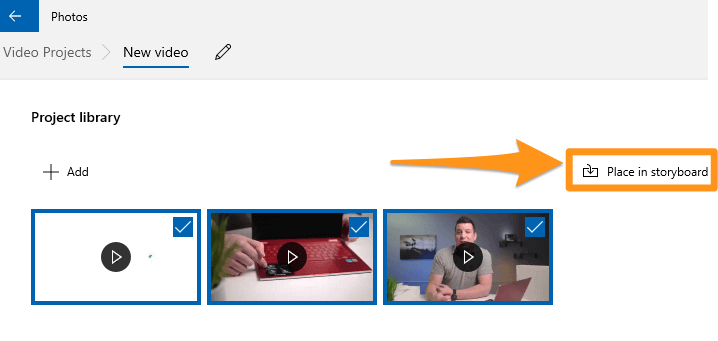
These are the steps to combine multiple clips in Windows 10 with Photos App.
Step 1: Open Photos App
Go to the ‘Start’ menu, find Photos App, and click to open it.
Step 2: Make a New Project
Click the ‘New video project’ (big blue box) under the ‘Video Projects’ tab. Alternatively, you can click the ‘New video’ button and select the ‘New video project’ option from the dropdown menu.
Step 3: Add Clips
Look for the text ‘Project library.’ Then click the ‘+ Add’ button. This will open a new window so you can select the clips you want to combine. Also, import videos one by one in a proper sequence because you cannot arrange them later.
Step 4: Make a Storyboard
After importing all the shots, you want to merge, click the ‘Place in storyboard’ button. This option will add all the chosen clips to your project’s storyboard.
- Fastreel by Movavi
Fastreel is a free online video editor. It is extremely easy to use right away, without installing anything. So, on Fastreel, one can edit videos or use online templates in the browser itself. Actually, the first tool we see in the list of Fastreel tools is to merge a video; then, it can be used in order to compress, make, cut, and create a video. On fastreel, you can add a watermark to a video, if wanted - so, it is very voluntary. As for the merging of a video, when this tool is chosen, it’s pretty simple to understand the steps – you can just drop/add multiple files right away.

The format must be either of the listed: MP4, MOV, MKV, AVI, and WMV, and the total size mustn’t exceed 500 MB. Then, in order to add some transitions, a style can be chosen from the drop-down menu, and after that, you should hit on Continue button to stitch the videos together. For the last step, you can export the result by selecting Download option.
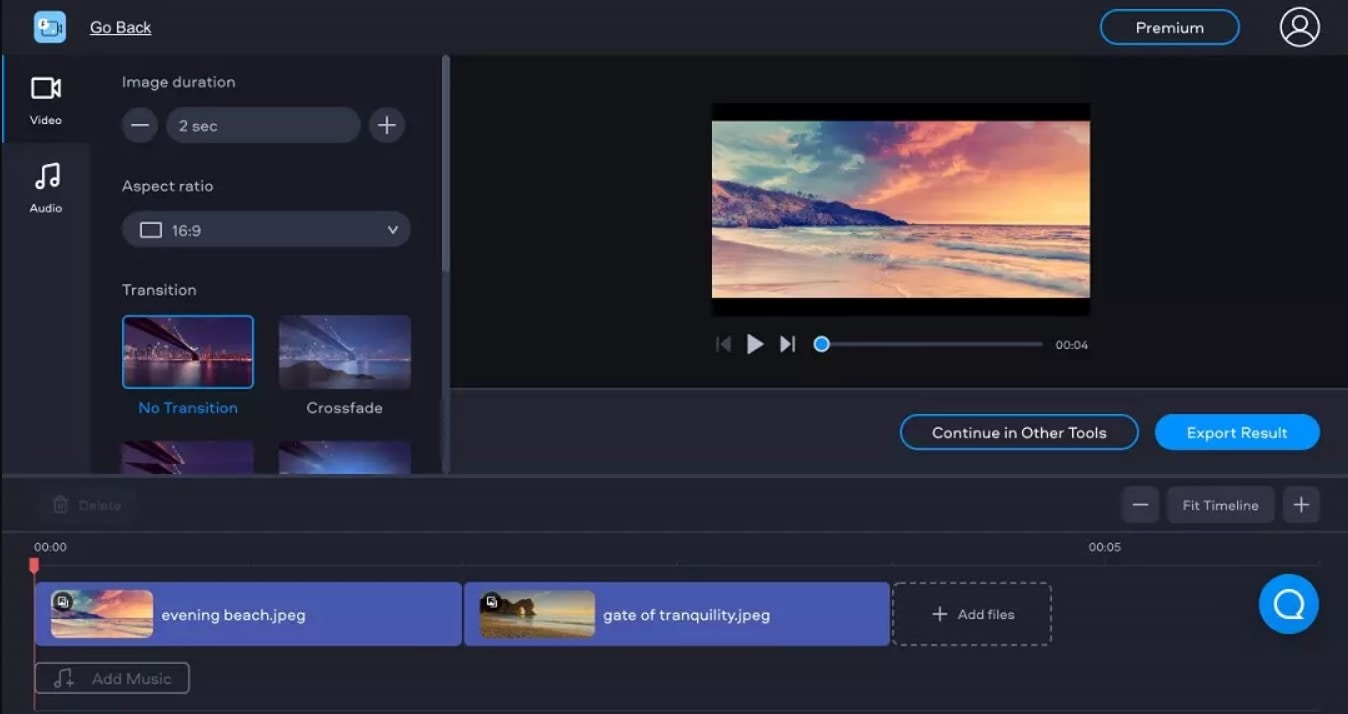
- Free Video Cutter Joiner
Free Video Cutter Joiner – the name already explains it all by itself! This is a free video merger which will not add watermark on your video. The software needs to be downloaded, and contributes to quickly cutting and joining videos. Free Video Cutter Joiner has no size limits – it can cut and merge videos with large file sizes without any trouble, and speed of it to do so is quite fast. It supports several file formats, such as AVI, MPEG, WMV, 3GP FLV, MP4, WMV, MOV, VOB, etc.
So, once downloaded, you will see how user-friendly and straightforward the software is: it shows two of its features right away – video cutter and video joiner. You choose which one you are about to use – so, in our case, video joiner.
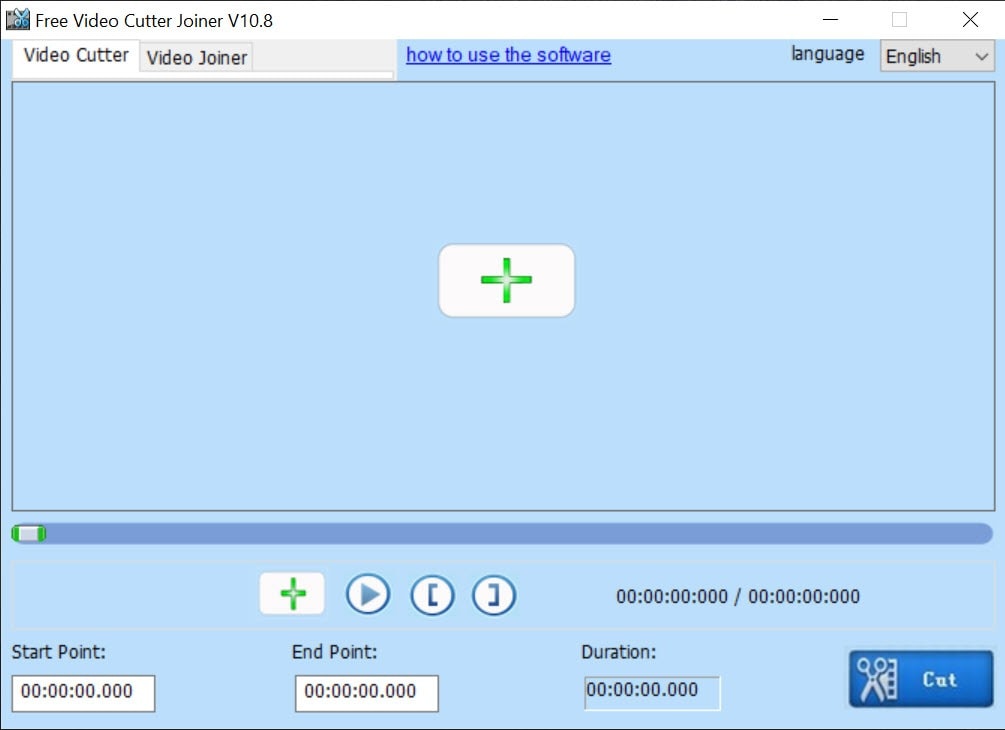
Then, you should click the the “+” icon, which lets you add files from your PC.

Then, hit on the Join button, and choose Indirect Join. Hitting on Start Join will start merging all the uploaded videos, and, wait a little until the process has been completed.
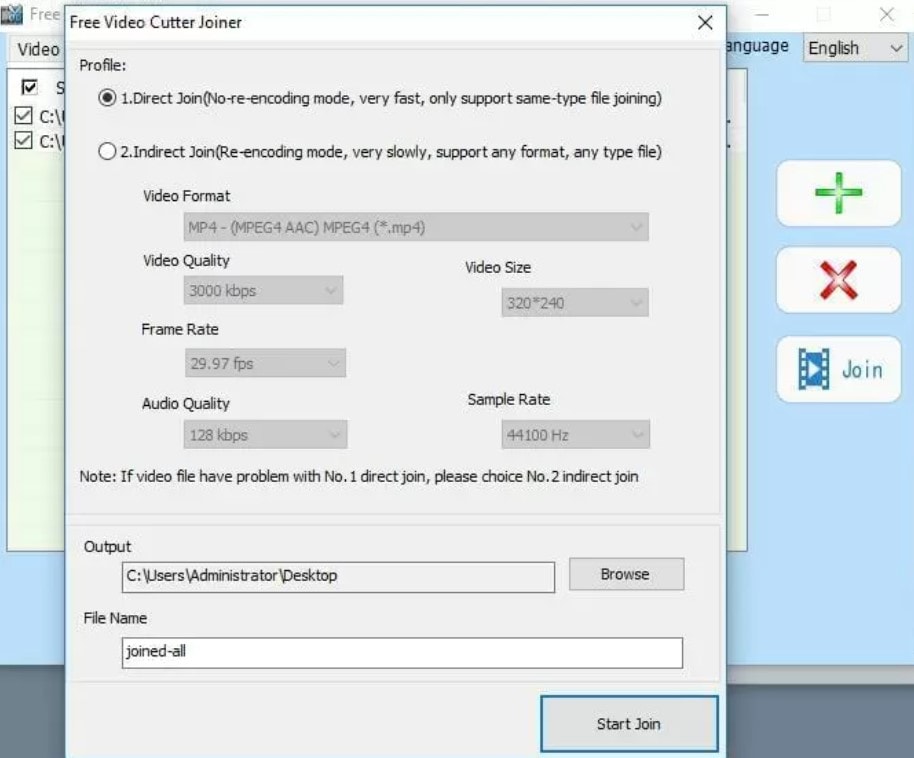
- Clideo
Clideo is the online platform that declares that it makes it super easy to edit all your video files, images and GIFs, and is totally free. It gives us the opportunities to: merge, compress, resize, cut, make, crop, speed, rotate, add music to, loop, flip, reverse, mute, filter, and adjust the videos. Add subtitles, make memes, create slideshows, etc. Therefore, it’s pretty rich in its tools and features.
As for merging videos, much like Fastreel, Clideo is pretty straightforward. You just click on the mentioned tool, and then easily choose files you would like to combine – you can merge any amount of video clips there. Several files can be chosen at the same time, or they can be added one by one.
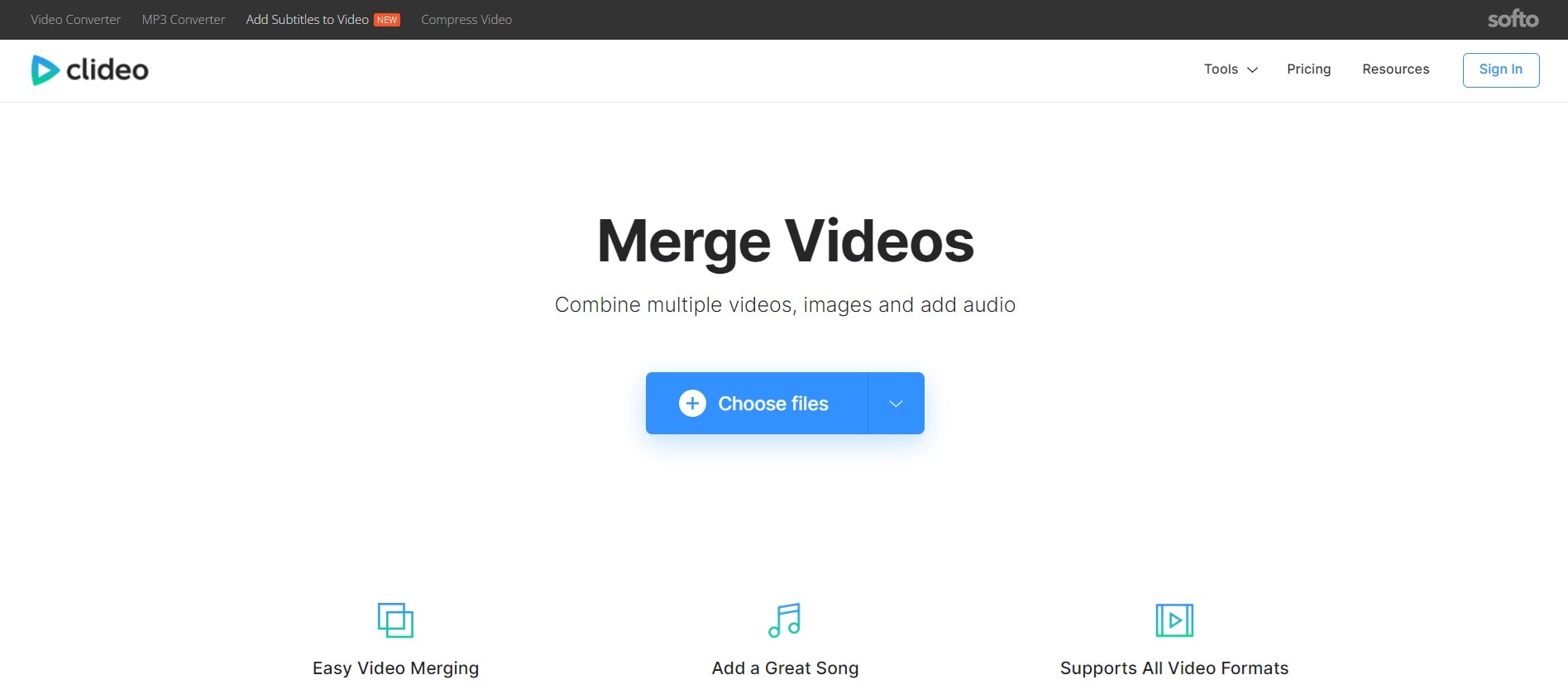
Then it will take you to the editor, where you can join the videos. It’s possible to rearrange the files, by using drag-and-drop until they’re in the desired order. You can also add images and set duration from them, add audio, change its length and volume. The last step is choosing the aspect ratio and clicking the Export button. You can watch the preview of your result and then click on Download if you are satisfied with the merged file.
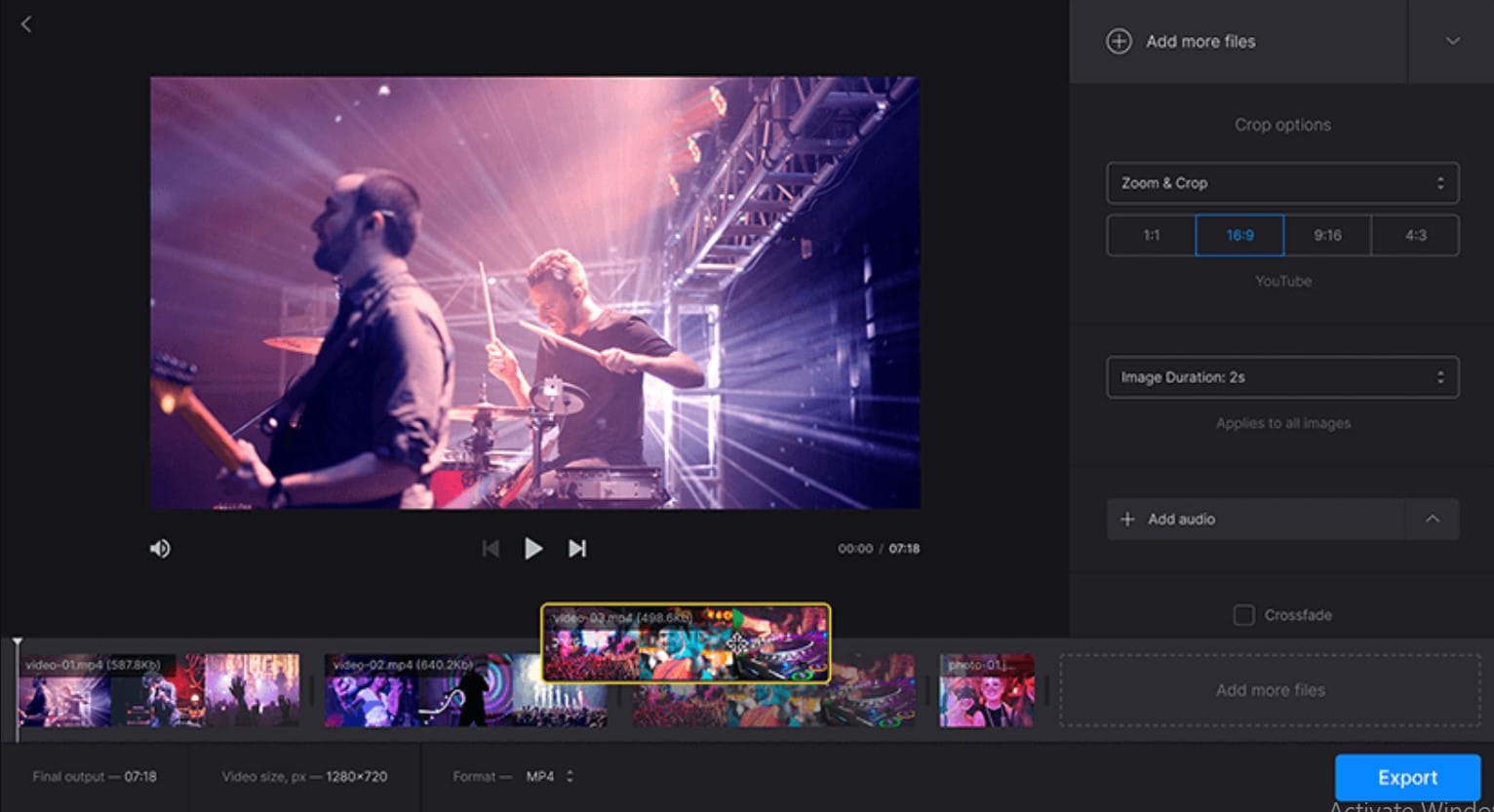
- Typito
Typito is a platform to merge videos online, as well as Fastreel and Clideo. It is free, and mostly aims to create combinations one can use to post on social network such as Instagram, Facebook, and Youtube. Typito supports a great many formats, some of them being MP4, AVI, FLV and WMV. You can edit your videos before merging them by trimming, cropping and resizing, and also add transition effects and music. It quickly combines footage, doesn’t watermark the videos, has brand kit of colors, fonts and style. It can also create collection of images, which is used for making Youtube compilation at most times.
To merge videos, you should choose the tool, then Get Started, and register and sign in first.
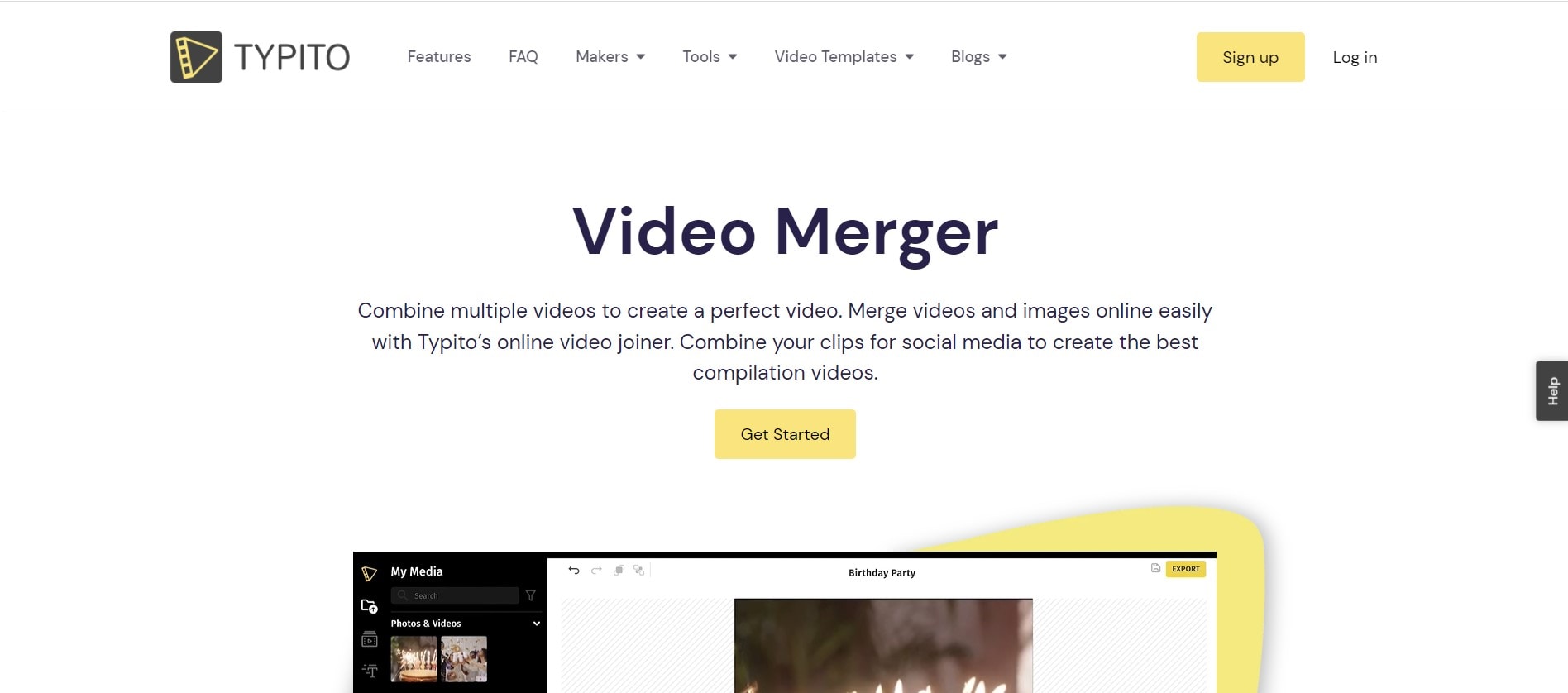
Then click on New Project, choose a video format (the platform offers you the list of the most popular ones), and it will take you to the editor, where you start off by adding media.
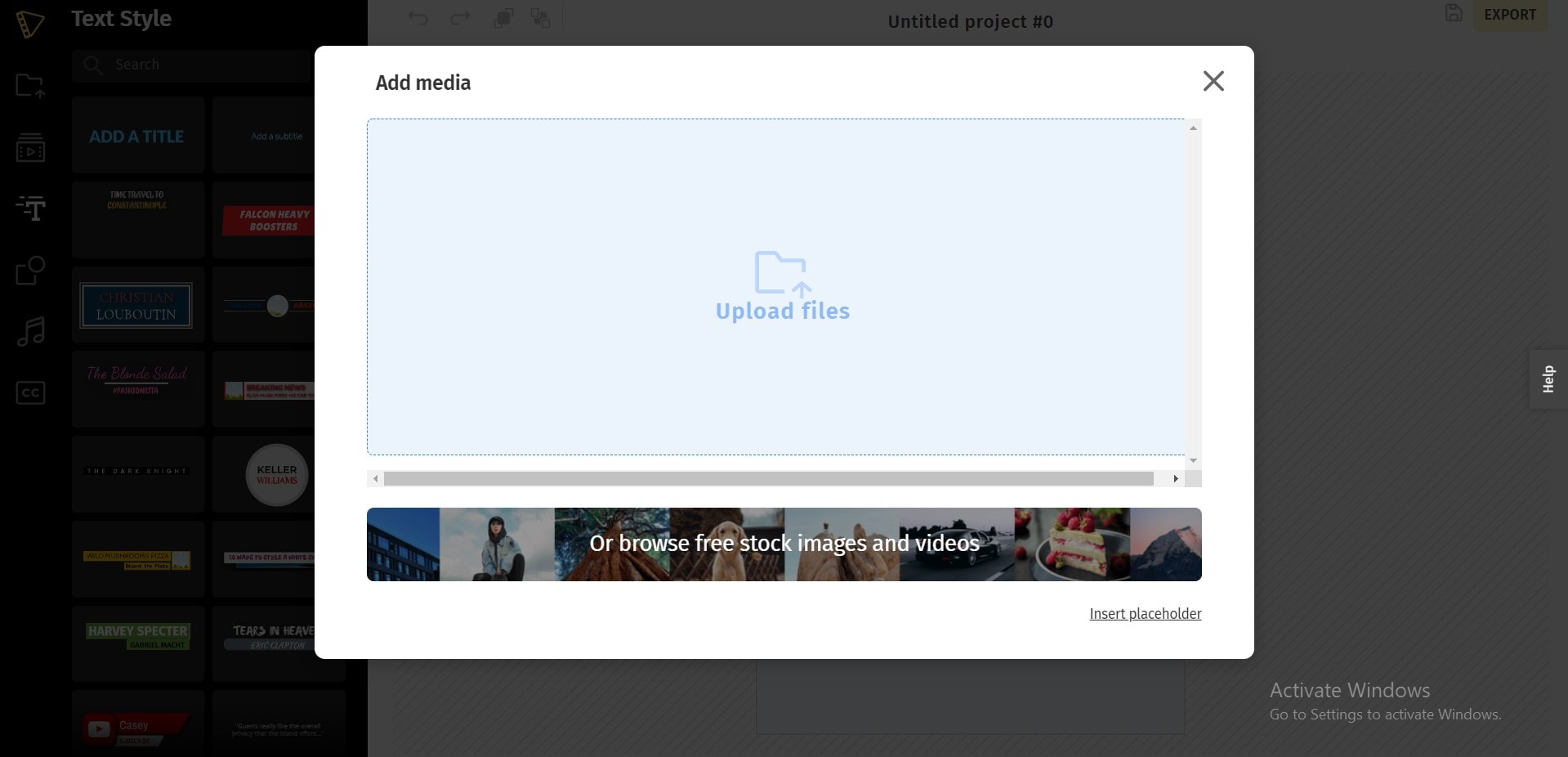
Drag and drop images or videos that you want to combine into a single video. You can also click to upload media files from your system or browse our Stock Media library for high-quality stock photos and video. Then, you can put your video clips in order, and work on it, if you want to use different tools, such as: edit, crop, trim, or resize them, as well as add text captions, images, and transitions. After you have previewed your video, you can click on the export button in the top right corner, and then, your merged video will be ready to be shared.
- Online UniConverter
Online UniConverter is the next online platform giving us the chance to merge our videos without watermark. It is an online analogue of Wondershare UniConverter, and is a very powerful platform, where you can trim, split, rotate, adjust, and download videos in HD quality. UniConverter supports numerous video formats, including MP4, AVI, MOV, MP3, WEBM. Online UniConverter offers various transitions and aspect ratios to fit the screen.
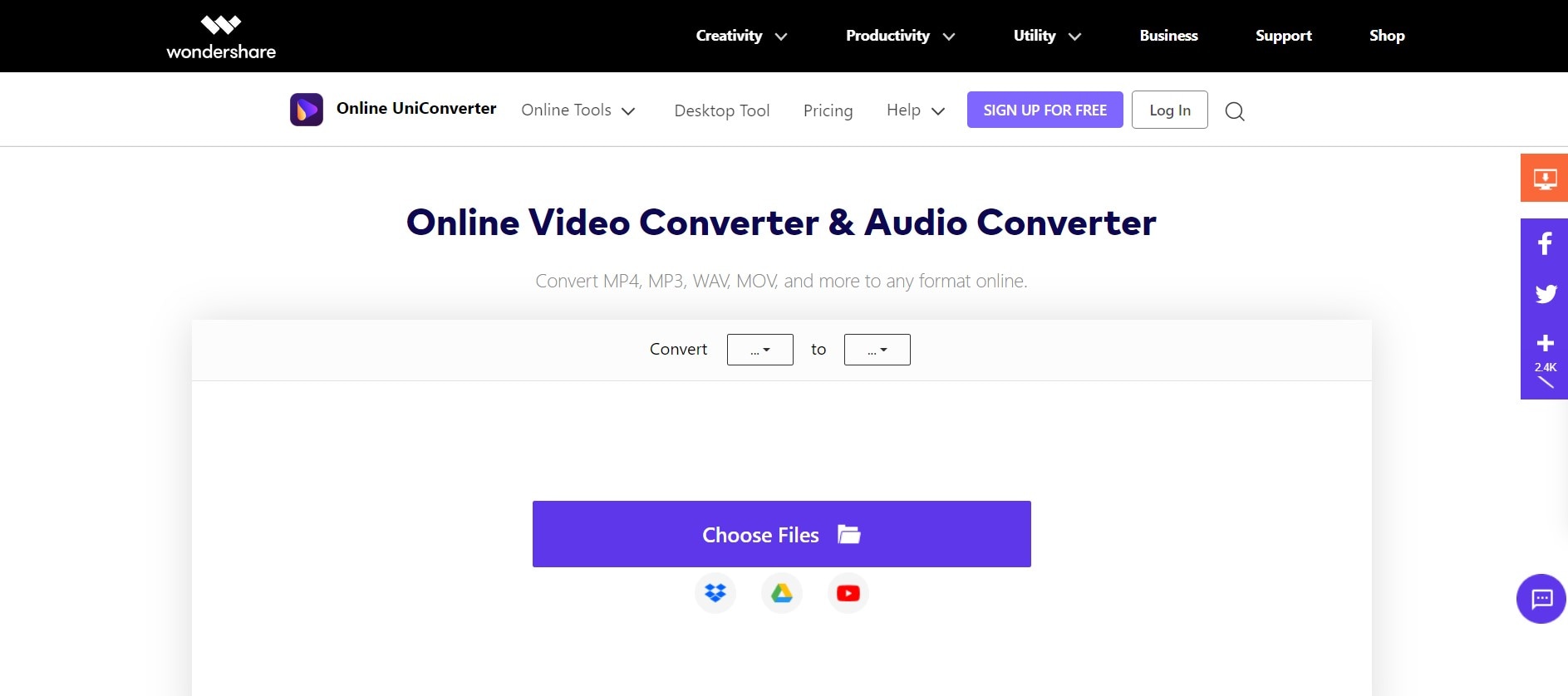
The web-site has lots of tools and features to offer: in the description of it, it reads: video converter, video compressor, video editor, audio converter, audio compressor, audio cutter, GIF maker, YouTube thumbnail, and image resizer. Importing media to the online UniConverter is extremely easy, and combining videos turns out to be a quick process, too.
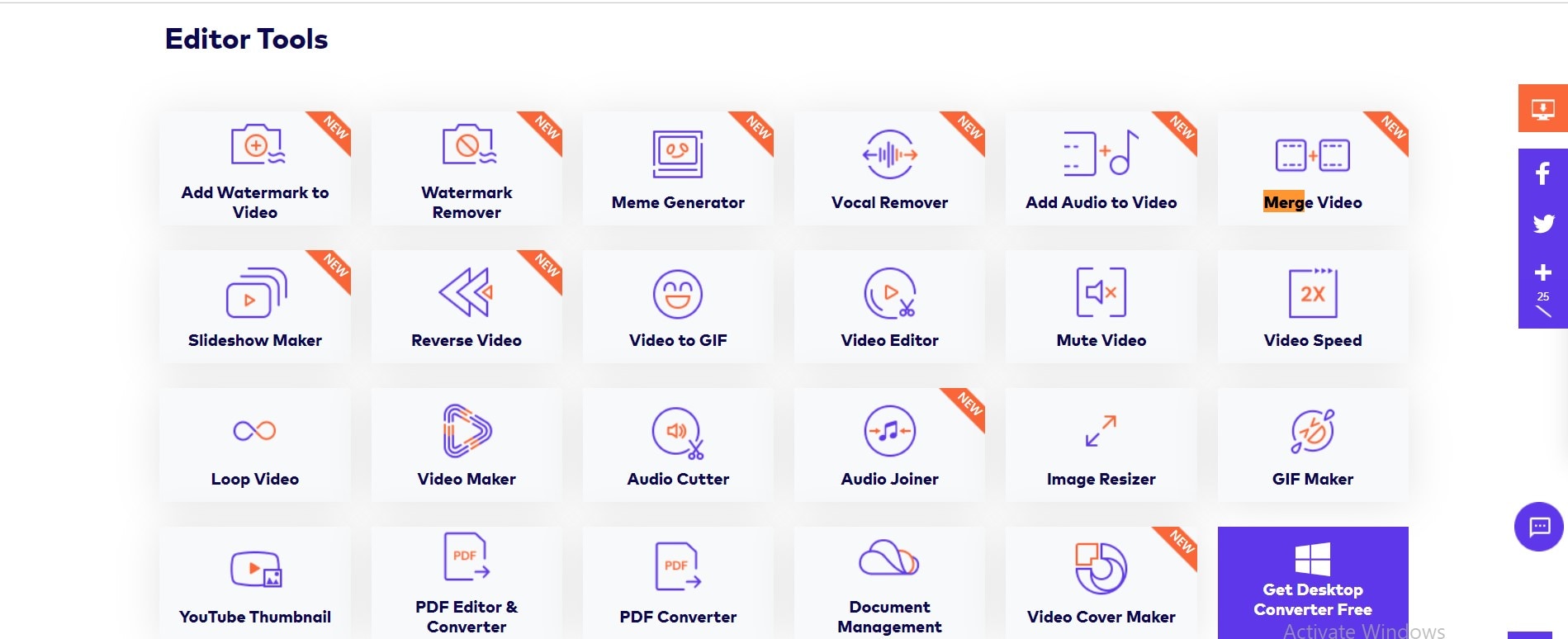
Anyway, if you want to combine a lot of files and the size of them all exceeds 100 MB, you will not be able to use Online Uniconverter for that. It supports the video no more than 100 MB and suggests using Wondershare UniConverter (originally Wondershare Video Converter Ultimate) for Desktop.
- Wondershare Filmora
Last but not least – Filmora Video Editor ! Even it differs from other abovementioned video mergers, as in it is not totally free and adds a Filmora logo on exported project, it’s a great suggestion for people who want to make their videos look great with the help of various tools. When a user is ready to pay, Filmora offers a subscription model, and for a bit more, one can get a permanent license. The software costs $51.99 per year or $79.99 for an outright purchase (prices are regularly discounted).
Wondershare Filmora has a clear and pleasing interface, offers trimming, transitions, overlays, several effects, as well as some more advanced and modern features, such as motion tracking. For this one particular software, we will be offering a step by step guide about how to merge videos there.
For Win 7 or later (64-bit)
For macOS 10.14 or later
- Open the program.
- Choose Import Media Files Here.

- Choose your
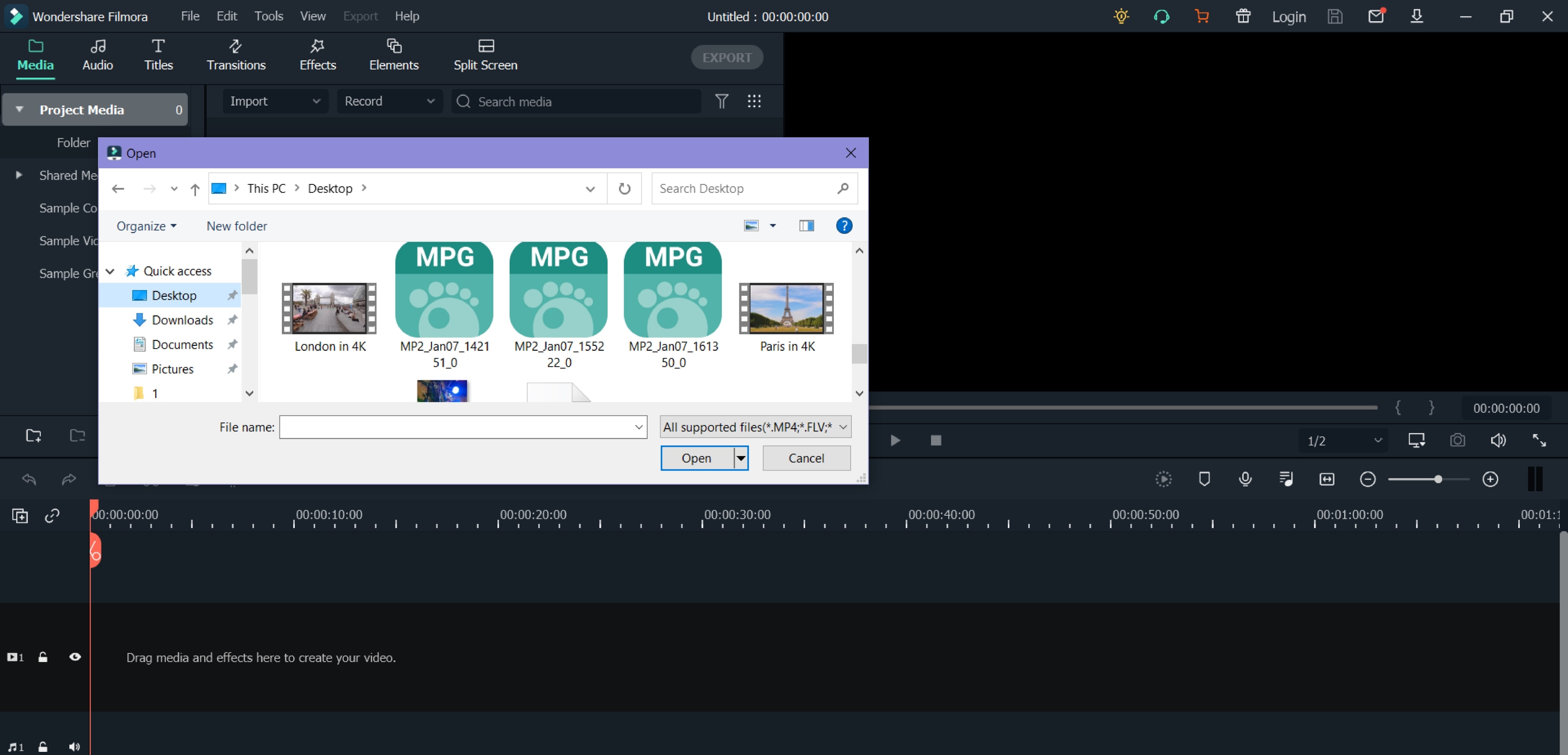
- We can click and drag, essentially, “insert” a video in a sequence below. The Linear Timeline allows us to understand exactly when a video clip ends and when a new one starts.

- Accordingly, we can make one video “sit” next to another. If we want or need it, we will add the third video clip, fourth, and so on.
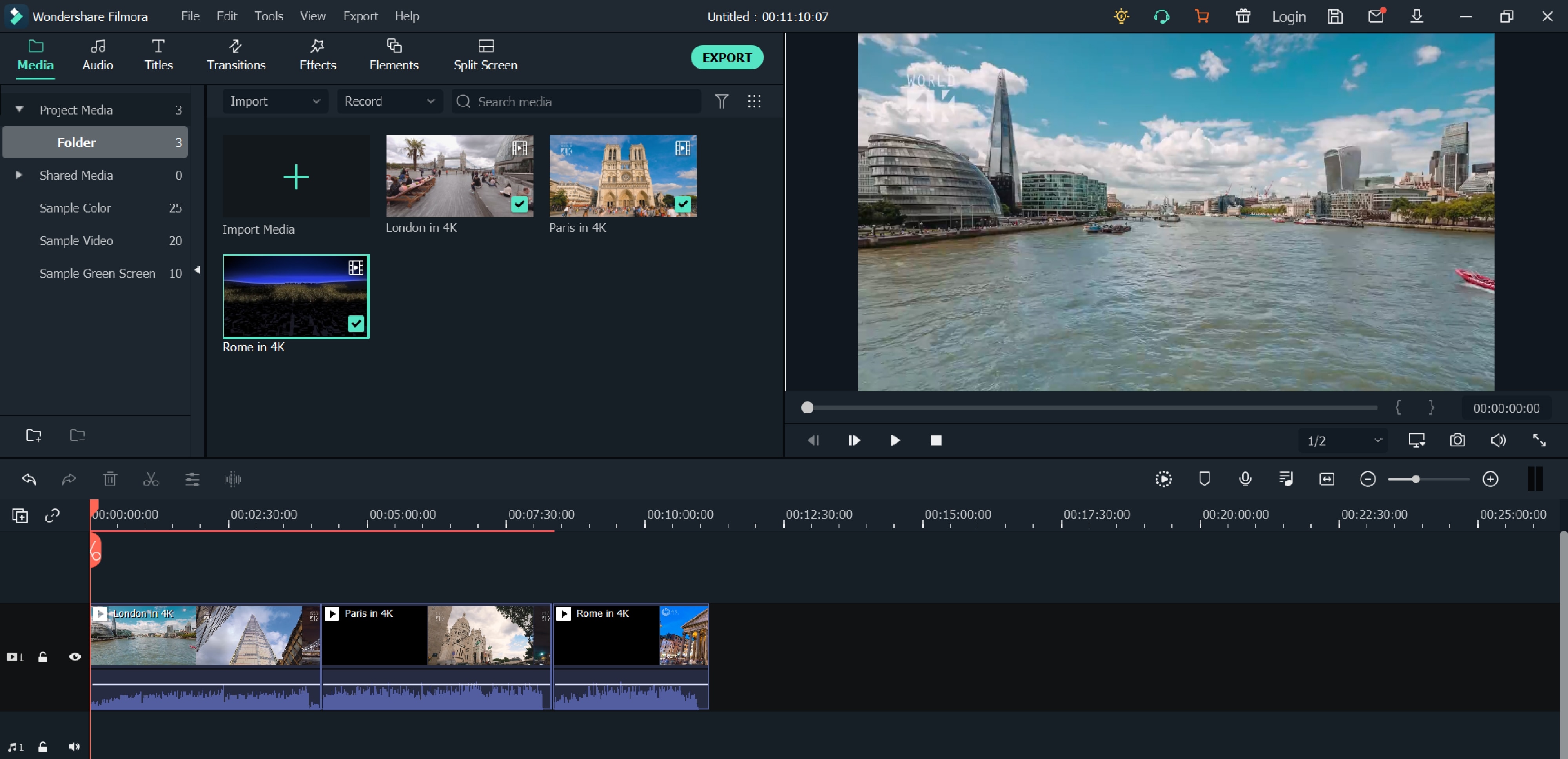
- We can view the entire video and save the video afterwards.
- Start to save video - we make sure the result is exactly what we wanted, find the Export button above the timeline and click on it.
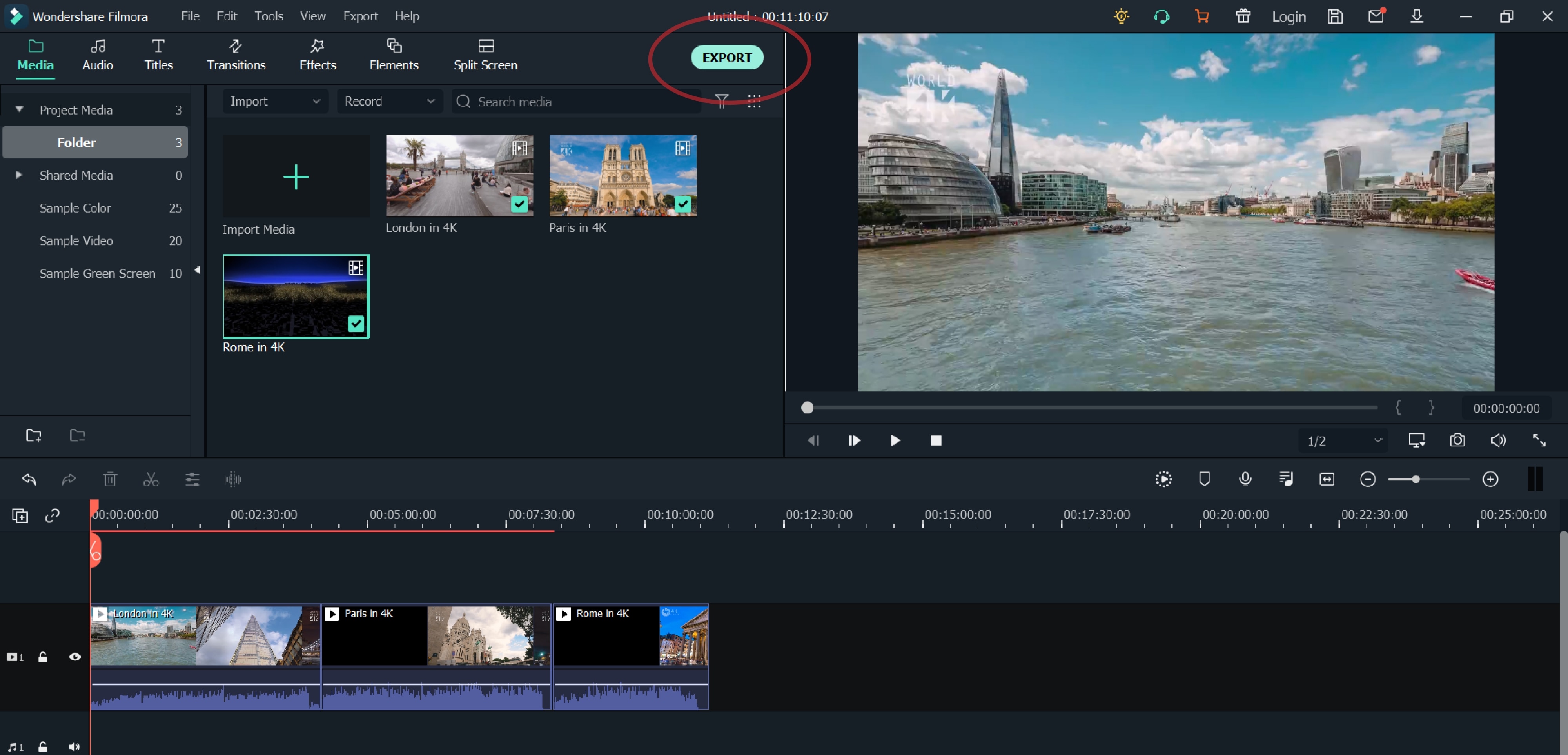
- In the opened window, on the left side, to be precise, if we observe well, we can already choose in which format we want to save our clip. On the right we can indicate what name we want to give to our video; The location where we want to store it; Also, we see the resolution (which we can modify freely after clicking on Settings); Size; Duration.
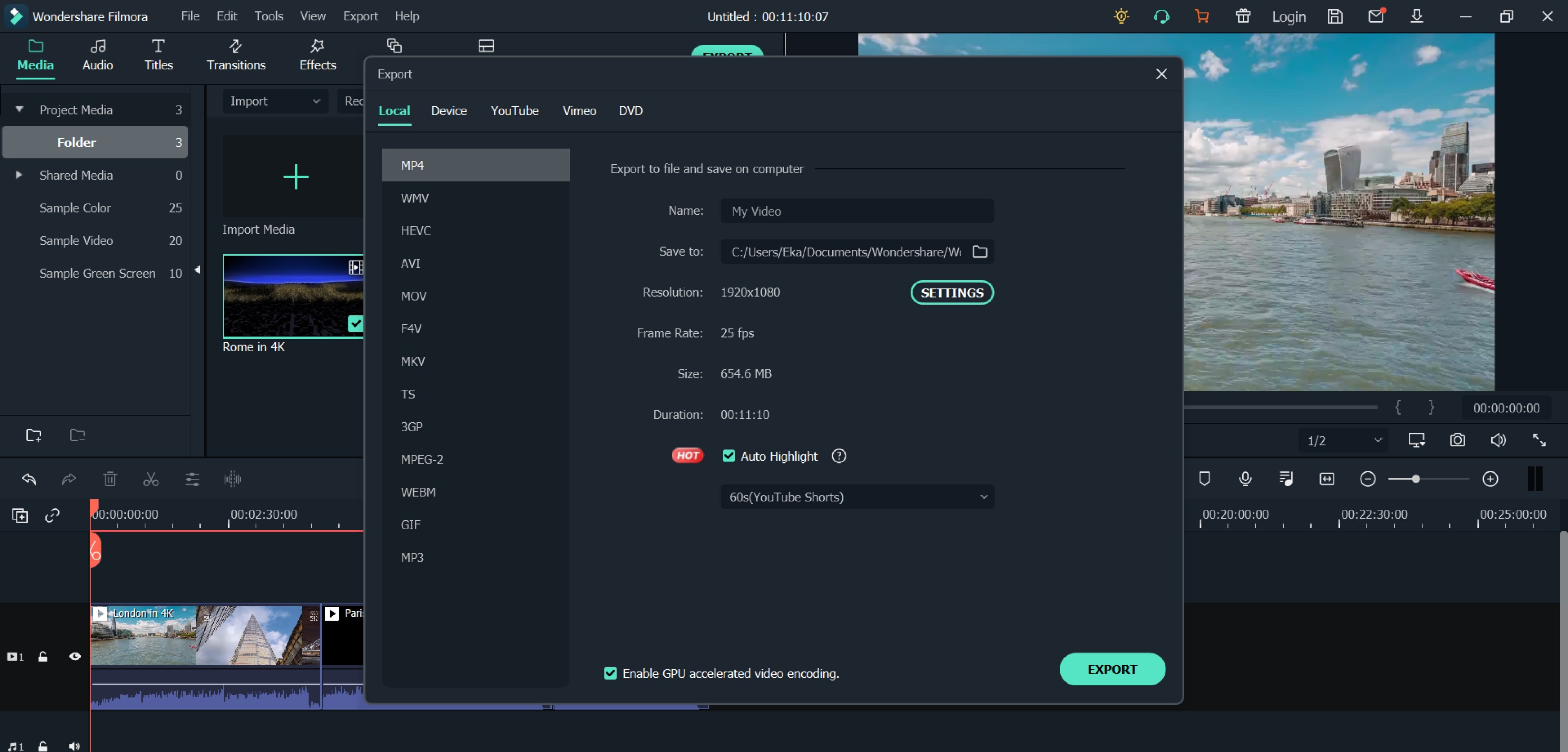
- In Settings, we can decide how much quality the video should have, how many kbps will be the Bit Rate, how many fps the Frame Rate should be, etc., but most likely, beginners will not need to change all this.
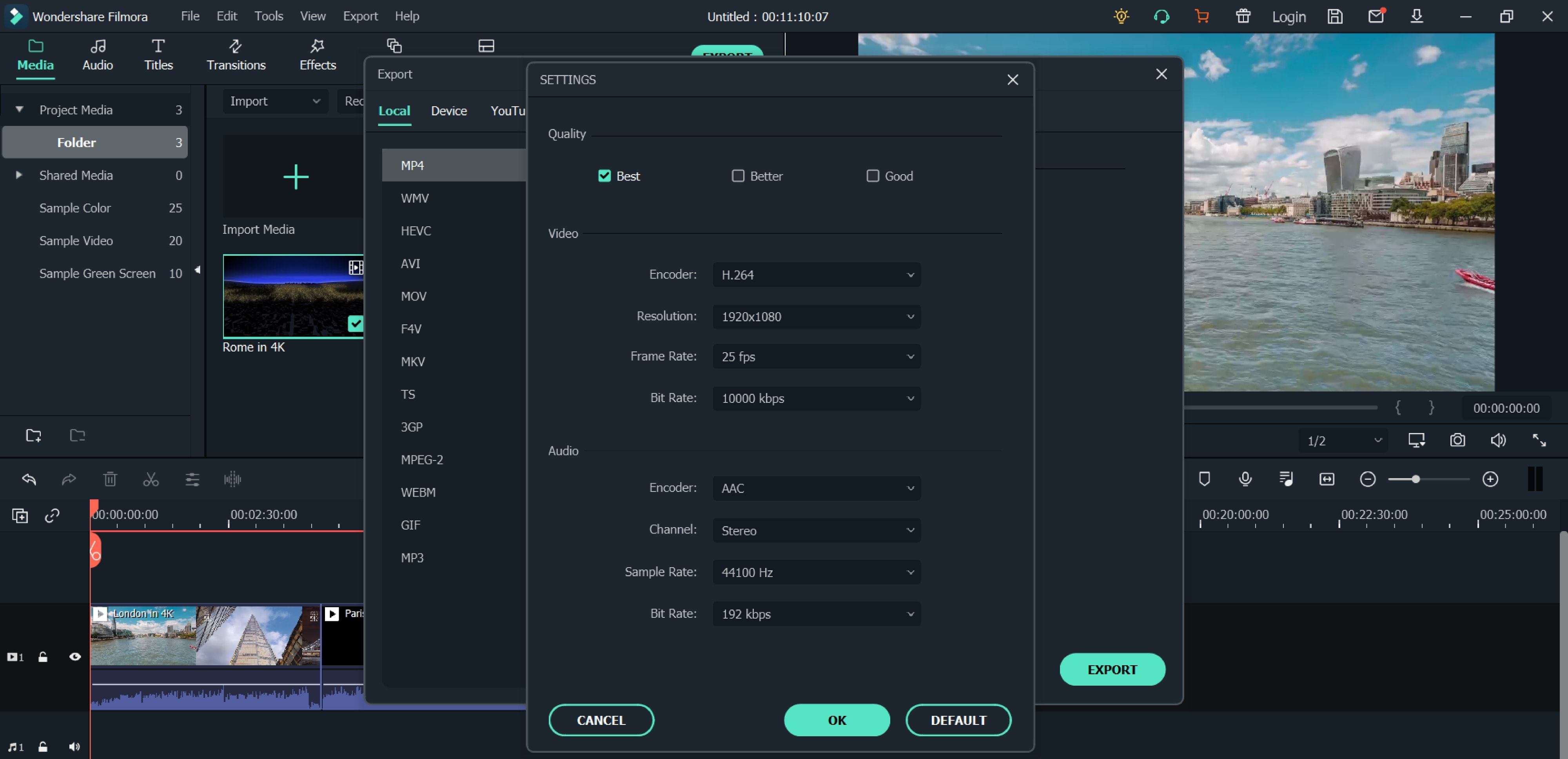
- After selecting everything, right-click on the Export button in the lower right corner of the window and the program will start saving the material.
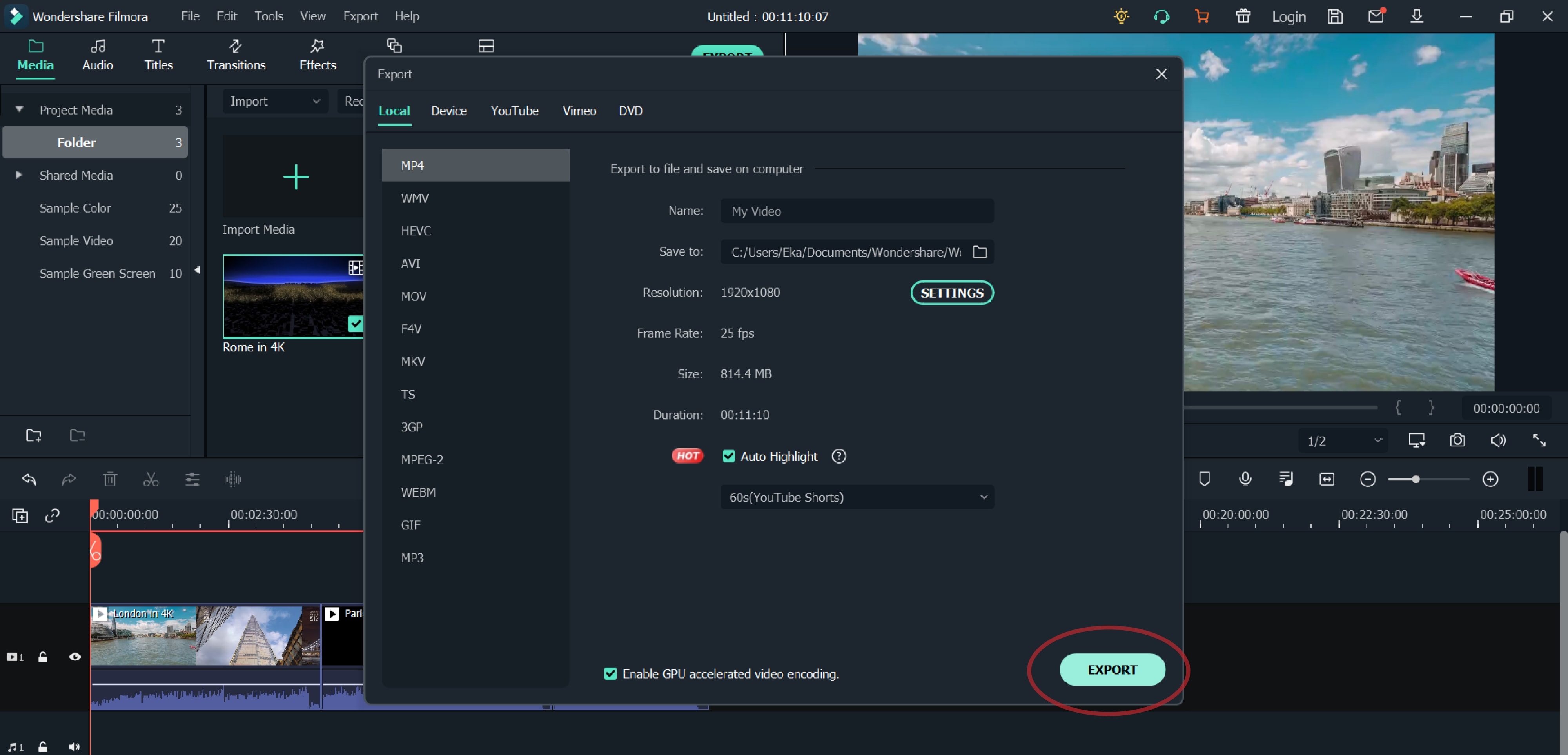

So, in this article, we introduced some online platforms and software for you to use if you would like to merge videos and combine them into one. These are: Fastreel, Free Video Cutter Joiner, Clideo, Typito, Online UniConverter, Wondershare Filmora. It’s up to you which one you would like to choose to merge your videos or edit them in any other way, but you can try either of them and choose to your own liking – even so, of course, there are some other video mergers worth considering, that we might mention in the coming articles. Before then, enjoy with free video editors, without watermark!
If you are too lazy to get high-quality results using popular video editors, like Filmora, try Photos App. It is a built-in program that usually opens your images on Windows 10, but you can also use it for merging your videos. And guess what? Since it comes within the system, all the features, although limited, are absolutely free.
How to Merge Videos on Windows using Photos App?

These are the steps to combine multiple clips in Windows 10 with Photos App.
Step 1: Open Photos App
Go to the ‘Start’ menu, find Photos App, and click to open it.
Step 2: Make a New Project
Click the ‘New video project’ (big blue box) under the ‘Video Projects’ tab. Alternatively, you can click the ‘New video’ button and select the ‘New video project’ option from the dropdown menu.
Step 3: Add Clips
Look for the text ‘Project library.’ Then click the ‘+ Add’ button. This will open a new window so you can select the clips you want to combine. Also, import videos one by one in a proper sequence because you cannot arrange them later.
Step 4: Make a Storyboard
After importing all the shots, you want to merge, click the ‘Place in storyboard’ button. This option will add all the chosen clips to your project’s storyboard.
- Fastreel by Movavi
Fastreel is a free online video editor. It is extremely easy to use right away, without installing anything. So, on Fastreel, one can edit videos or use online templates in the browser itself. Actually, the first tool we see in the list of Fastreel tools is to merge a video; then, it can be used in order to compress, make, cut, and create a video. On fastreel, you can add a watermark to a video, if wanted - so, it is very voluntary. As for the merging of a video, when this tool is chosen, it’s pretty simple to understand the steps – you can just drop/add multiple files right away.

The format must be either of the listed: MP4, MOV, MKV, AVI, and WMV, and the total size mustn’t exceed 500 MB. Then, in order to add some transitions, a style can be chosen from the drop-down menu, and after that, you should hit on Continue button to stitch the videos together. For the last step, you can export the result by selecting Download option.

- Free Video Cutter Joiner
Free Video Cutter Joiner – the name already explains it all by itself! This is a free video merger which will not add watermark on your video. The software needs to be downloaded, and contributes to quickly cutting and joining videos. Free Video Cutter Joiner has no size limits – it can cut and merge videos with large file sizes without any trouble, and speed of it to do so is quite fast. It supports several file formats, such as AVI, MPEG, WMV, 3GP FLV, MP4, WMV, MOV, VOB, etc.
So, once downloaded, you will see how user-friendly and straightforward the software is: it shows two of its features right away – video cutter and video joiner. You choose which one you are about to use – so, in our case, video joiner.

Then, you should click the the “+” icon, which lets you add files from your PC.

Then, hit on the Join button, and choose Indirect Join. Hitting on Start Join will start merging all the uploaded videos, and, wait a little until the process has been completed.

- Clideo
Clideo is the online platform that declares that it makes it super easy to edit all your video files, images and GIFs, and is totally free. It gives us the opportunities to: merge, compress, resize, cut, make, crop, speed, rotate, add music to, loop, flip, reverse, mute, filter, and adjust the videos. Add subtitles, make memes, create slideshows, etc. Therefore, it’s pretty rich in its tools and features.
As for merging videos, much like Fastreel, Clideo is pretty straightforward. You just click on the mentioned tool, and then easily choose files you would like to combine – you can merge any amount of video clips there. Several files can be chosen at the same time, or they can be added one by one.

Then it will take you to the editor, where you can join the videos. It’s possible to rearrange the files, by using drag-and-drop until they’re in the desired order. You can also add images and set duration from them, add audio, change its length and volume. The last step is choosing the aspect ratio and clicking the Export button. You can watch the preview of your result and then click on Download if you are satisfied with the merged file.

- Typito
Typito is a platform to merge videos online, as well as Fastreel and Clideo. It is free, and mostly aims to create combinations one can use to post on social network such as Instagram, Facebook, and Youtube. Typito supports a great many formats, some of them being MP4, AVI, FLV and WMV. You can edit your videos before merging them by trimming, cropping and resizing, and also add transition effects and music. It quickly combines footage, doesn’t watermark the videos, has brand kit of colors, fonts and style. It can also create collection of images, which is used for making Youtube compilation at most times.
To merge videos, you should choose the tool, then Get Started, and register and sign in first.

Then click on New Project, choose a video format (the platform offers you the list of the most popular ones), and it will take you to the editor, where you start off by adding media.

Drag and drop images or videos that you want to combine into a single video. You can also click to upload media files from your system or browse our Stock Media library for high-quality stock photos and video. Then, you can put your video clips in order, and work on it, if you want to use different tools, such as: edit, crop, trim, or resize them, as well as add text captions, images, and transitions. After you have previewed your video, you can click on the export button in the top right corner, and then, your merged video will be ready to be shared.
- Online UniConverter
Online UniConverter is the next online platform giving us the chance to merge our videos without watermark. It is an online analogue of Wondershare UniConverter, and is a very powerful platform, where you can trim, split, rotate, adjust, and download videos in HD quality. UniConverter supports numerous video formats, including MP4, AVI, MOV, MP3, WEBM. Online UniConverter offers various transitions and aspect ratios to fit the screen.

The web-site has lots of tools and features to offer: in the description of it, it reads: video converter, video compressor, video editor, audio converter, audio compressor, audio cutter, GIF maker, YouTube thumbnail, and image resizer. Importing media to the online UniConverter is extremely easy, and combining videos turns out to be a quick process, too.

Anyway, if you want to combine a lot of files and the size of them all exceeds 100 MB, you will not be able to use Online Uniconverter for that. It supports the video no more than 100 MB and suggests using Wondershare UniConverter (originally Wondershare Video Converter Ultimate) for Desktop.
- Wondershare Filmora
Last but not least – Filmora Video Editor ! Even it differs from other abovementioned video mergers, as in it is not totally free and adds a Filmora logo on exported project, it’s a great suggestion for people who want to make their videos look great with the help of various tools. When a user is ready to pay, Filmora offers a subscription model, and for a bit more, one can get a permanent license. The software costs $51.99 per year or $79.99 for an outright purchase (prices are regularly discounted).
Wondershare Filmora has a clear and pleasing interface, offers trimming, transitions, overlays, several effects, as well as some more advanced and modern features, such as motion tracking. For this one particular software, we will be offering a step by step guide about how to merge videos there.
For Win 7 or later (64-bit)
For macOS 10.14 or later
- Open the program.
- Choose Import Media Files Here.

- Choose your

- We can click and drag, essentially, “insert” a video in a sequence below. The Linear Timeline allows us to understand exactly when a video clip ends and when a new one starts.

- Accordingly, we can make one video “sit” next to another. If we want or need it, we will add the third video clip, fourth, and so on.

- We can view the entire video and save the video afterwards.
- Start to save video - we make sure the result is exactly what we wanted, find the Export button above the timeline and click on it.

- In the opened window, on the left side, to be precise, if we observe well, we can already choose in which format we want to save our clip. On the right we can indicate what name we want to give to our video; The location where we want to store it; Also, we see the resolution (which we can modify freely after clicking on Settings); Size; Duration.

- In Settings, we can decide how much quality the video should have, how many kbps will be the Bit Rate, how many fps the Frame Rate should be, etc., but most likely, beginners will not need to change all this.

- After selecting everything, right-click on the Export button in the lower right corner of the window and the program will start saving the material.


So, in this article, we introduced some online platforms and software for you to use if you would like to merge videos and combine them into one. These are: Fastreel, Free Video Cutter Joiner, Clideo, Typito, Online UniConverter, Wondershare Filmora. It’s up to you which one you would like to choose to merge your videos or edit them in any other way, but you can try either of them and choose to your own liking – even so, of course, there are some other video mergers worth considering, that we might mention in the coming articles. Before then, enjoy with free video editors, without watermark!
If you are too lazy to get high-quality results using popular video editors, like Filmora, try Photos App. It is a built-in program that usually opens your images on Windows 10, but you can also use it for merging your videos. And guess what? Since it comes within the system, all the features, although limited, are absolutely free.
How to Merge Videos on Windows using Photos App?

These are the steps to combine multiple clips in Windows 10 with Photos App.
Step 1: Open Photos App
Go to the ‘Start’ menu, find Photos App, and click to open it.
Step 2: Make a New Project
Click the ‘New video project’ (big blue box) under the ‘Video Projects’ tab. Alternatively, you can click the ‘New video’ button and select the ‘New video project’ option from the dropdown menu.
Step 3: Add Clips
Look for the text ‘Project library.’ Then click the ‘+ Add’ button. This will open a new window so you can select the clips you want to combine. Also, import videos one by one in a proper sequence because you cannot arrange them later.
Step 4: Make a Storyboard
After importing all the shots, you want to merge, click the ‘Place in storyboard’ button. This option will add all the chosen clips to your project’s storyboard.
- Fastreel by Movavi
Fastreel is a free online video editor. It is extremely easy to use right away, without installing anything. So, on Fastreel, one can edit videos or use online templates in the browser itself. Actually, the first tool we see in the list of Fastreel tools is to merge a video; then, it can be used in order to compress, make, cut, and create a video. On fastreel, you can add a watermark to a video, if wanted - so, it is very voluntary. As for the merging of a video, when this tool is chosen, it’s pretty simple to understand the steps – you can just drop/add multiple files right away.

The format must be either of the listed: MP4, MOV, MKV, AVI, and WMV, and the total size mustn’t exceed 500 MB. Then, in order to add some transitions, a style can be chosen from the drop-down menu, and after that, you should hit on Continue button to stitch the videos together. For the last step, you can export the result by selecting Download option.

- Free Video Cutter Joiner
Free Video Cutter Joiner – the name already explains it all by itself! This is a free video merger which will not add watermark on your video. The software needs to be downloaded, and contributes to quickly cutting and joining videos. Free Video Cutter Joiner has no size limits – it can cut and merge videos with large file sizes without any trouble, and speed of it to do so is quite fast. It supports several file formats, such as AVI, MPEG, WMV, 3GP FLV, MP4, WMV, MOV, VOB, etc.
So, once downloaded, you will see how user-friendly and straightforward the software is: it shows two of its features right away – video cutter and video joiner. You choose which one you are about to use – so, in our case, video joiner.

Then, you should click the the “+” icon, which lets you add files from your PC.

Then, hit on the Join button, and choose Indirect Join. Hitting on Start Join will start merging all the uploaded videos, and, wait a little until the process has been completed.

- Clideo
Clideo is the online platform that declares that it makes it super easy to edit all your video files, images and GIFs, and is totally free. It gives us the opportunities to: merge, compress, resize, cut, make, crop, speed, rotate, add music to, loop, flip, reverse, mute, filter, and adjust the videos. Add subtitles, make memes, create slideshows, etc. Therefore, it’s pretty rich in its tools and features.
As for merging videos, much like Fastreel, Clideo is pretty straightforward. You just click on the mentioned tool, and then easily choose files you would like to combine – you can merge any amount of video clips there. Several files can be chosen at the same time, or they can be added one by one.

Then it will take you to the editor, where you can join the videos. It’s possible to rearrange the files, by using drag-and-drop until they’re in the desired order. You can also add images and set duration from them, add audio, change its length and volume. The last step is choosing the aspect ratio and clicking the Export button. You can watch the preview of your result and then click on Download if you are satisfied with the merged file.

- Typito
Typito is a platform to merge videos online, as well as Fastreel and Clideo. It is free, and mostly aims to create combinations one can use to post on social network such as Instagram, Facebook, and Youtube. Typito supports a great many formats, some of them being MP4, AVI, FLV and WMV. You can edit your videos before merging them by trimming, cropping and resizing, and also add transition effects and music. It quickly combines footage, doesn’t watermark the videos, has brand kit of colors, fonts and style. It can also create collection of images, which is used for making Youtube compilation at most times.
To merge videos, you should choose the tool, then Get Started, and register and sign in first.

Then click on New Project, choose a video format (the platform offers you the list of the most popular ones), and it will take you to the editor, where you start off by adding media.

Drag and drop images or videos that you want to combine into a single video. You can also click to upload media files from your system or browse our Stock Media library for high-quality stock photos and video. Then, you can put your video clips in order, and work on it, if you want to use different tools, such as: edit, crop, trim, or resize them, as well as add text captions, images, and transitions. After you have previewed your video, you can click on the export button in the top right corner, and then, your merged video will be ready to be shared.
- Online UniConverter
Online UniConverter is the next online platform giving us the chance to merge our videos without watermark. It is an online analogue of Wondershare UniConverter, and is a very powerful platform, where you can trim, split, rotate, adjust, and download videos in HD quality. UniConverter supports numerous video formats, including MP4, AVI, MOV, MP3, WEBM. Online UniConverter offers various transitions and aspect ratios to fit the screen.

The web-site has lots of tools and features to offer: in the description of it, it reads: video converter, video compressor, video editor, audio converter, audio compressor, audio cutter, GIF maker, YouTube thumbnail, and image resizer. Importing media to the online UniConverter is extremely easy, and combining videos turns out to be a quick process, too.

Anyway, if you want to combine a lot of files and the size of them all exceeds 100 MB, you will not be able to use Online Uniconverter for that. It supports the video no more than 100 MB and suggests using Wondershare UniConverter (originally Wondershare Video Converter Ultimate) for Desktop.
- Wondershare Filmora
Last but not least – Filmora Video Editor ! Even it differs from other abovementioned video mergers, as in it is not totally free and adds a Filmora logo on exported project, it’s a great suggestion for people who want to make their videos look great with the help of various tools. When a user is ready to pay, Filmora offers a subscription model, and for a bit more, one can get a permanent license. The software costs $51.99 per year or $79.99 for an outright purchase (prices are regularly discounted).
Wondershare Filmora has a clear and pleasing interface, offers trimming, transitions, overlays, several effects, as well as some more advanced and modern features, such as motion tracking. For this one particular software, we will be offering a step by step guide about how to merge videos there.
For Win 7 or later (64-bit)
For macOS 10.14 or later
- Open the program.
- Choose Import Media Files Here.

- Choose your

- We can click and drag, essentially, “insert” a video in a sequence below. The Linear Timeline allows us to understand exactly when a video clip ends and when a new one starts.

- Accordingly, we can make one video “sit” next to another. If we want or need it, we will add the third video clip, fourth, and so on.

- We can view the entire video and save the video afterwards.
- Start to save video - we make sure the result is exactly what we wanted, find the Export button above the timeline and click on it.

- In the opened window, on the left side, to be precise, if we observe well, we can already choose in which format we want to save our clip. On the right we can indicate what name we want to give to our video; The location where we want to store it; Also, we see the resolution (which we can modify freely after clicking on Settings); Size; Duration.

- In Settings, we can decide how much quality the video should have, how many kbps will be the Bit Rate, how many fps the Frame Rate should be, etc., but most likely, beginners will not need to change all this.

- After selecting everything, right-click on the Export button in the lower right corner of the window and the program will start saving the material.


So, in this article, we introduced some online platforms and software for you to use if you would like to merge videos and combine them into one. These are: Fastreel, Free Video Cutter Joiner, Clideo, Typito, Online UniConverter, Wondershare Filmora. It’s up to you which one you would like to choose to merge your videos or edit them in any other way, but you can try either of them and choose to your own liking – even so, of course, there are some other video mergers worth considering, that we might mention in the coming articles. Before then, enjoy with free video editors, without watermark!
If you are too lazy to get high-quality results using popular video editors, like Filmora, try Photos App. It is a built-in program that usually opens your images on Windows 10, but you can also use it for merging your videos. And guess what? Since it comes within the system, all the features, although limited, are absolutely free.
How to Merge Videos on Windows using Photos App?

These are the steps to combine multiple clips in Windows 10 with Photos App.
Step 1: Open Photos App
Go to the ‘Start’ menu, find Photos App, and click to open it.
Step 2: Make a New Project
Click the ‘New video project’ (big blue box) under the ‘Video Projects’ tab. Alternatively, you can click the ‘New video’ button and select the ‘New video project’ option from the dropdown menu.
Step 3: Add Clips
Look for the text ‘Project library.’ Then click the ‘+ Add’ button. This will open a new window so you can select the clips you want to combine. Also, import videos one by one in a proper sequence because you cannot arrange them later.
Step 4: Make a Storyboard
After importing all the shots, you want to merge, click the ‘Place in storyboard’ button. This option will add all the chosen clips to your project’s storyboard.
- Fastreel by Movavi
Fastreel is a free online video editor. It is extremely easy to use right away, without installing anything. So, on Fastreel, one can edit videos or use online templates in the browser itself. Actually, the first tool we see in the list of Fastreel tools is to merge a video; then, it can be used in order to compress, make, cut, and create a video. On fastreel, you can add a watermark to a video, if wanted - so, it is very voluntary. As for the merging of a video, when this tool is chosen, it’s pretty simple to understand the steps – you can just drop/add multiple files right away.

The format must be either of the listed: MP4, MOV, MKV, AVI, and WMV, and the total size mustn’t exceed 500 MB. Then, in order to add some transitions, a style can be chosen from the drop-down menu, and after that, you should hit on Continue button to stitch the videos together. For the last step, you can export the result by selecting Download option.

- Free Video Cutter Joiner
Free Video Cutter Joiner – the name already explains it all by itself! This is a free video merger which will not add watermark on your video. The software needs to be downloaded, and contributes to quickly cutting and joining videos. Free Video Cutter Joiner has no size limits – it can cut and merge videos with large file sizes without any trouble, and speed of it to do so is quite fast. It supports several file formats, such as AVI, MPEG, WMV, 3GP FLV, MP4, WMV, MOV, VOB, etc.
So, once downloaded, you will see how user-friendly and straightforward the software is: it shows two of its features right away – video cutter and video joiner. You choose which one you are about to use – so, in our case, video joiner.

Then, you should click the the “+” icon, which lets you add files from your PC.

Then, hit on the Join button, and choose Indirect Join. Hitting on Start Join will start merging all the uploaded videos, and, wait a little until the process has been completed.

- Clideo
Clideo is the online platform that declares that it makes it super easy to edit all your video files, images and GIFs, and is totally free. It gives us the opportunities to: merge, compress, resize, cut, make, crop, speed, rotate, add music to, loop, flip, reverse, mute, filter, and adjust the videos. Add subtitles, make memes, create slideshows, etc. Therefore, it’s pretty rich in its tools and features.
As for merging videos, much like Fastreel, Clideo is pretty straightforward. You just click on the mentioned tool, and then easily choose files you would like to combine – you can merge any amount of video clips there. Several files can be chosen at the same time, or they can be added one by one.

Then it will take you to the editor, where you can join the videos. It’s possible to rearrange the files, by using drag-and-drop until they’re in the desired order. You can also add images and set duration from them, add audio, change its length and volume. The last step is choosing the aspect ratio and clicking the Export button. You can watch the preview of your result and then click on Download if you are satisfied with the merged file.

- Typito
Typito is a platform to merge videos online, as well as Fastreel and Clideo. It is free, and mostly aims to create combinations one can use to post on social network such as Instagram, Facebook, and Youtube. Typito supports a great many formats, some of them being MP4, AVI, FLV and WMV. You can edit your videos before merging them by trimming, cropping and resizing, and also add transition effects and music. It quickly combines footage, doesn’t watermark the videos, has brand kit of colors, fonts and style. It can also create collection of images, which is used for making Youtube compilation at most times.
To merge videos, you should choose the tool, then Get Started, and register and sign in first.

Then click on New Project, choose a video format (the platform offers you the list of the most popular ones), and it will take you to the editor, where you start off by adding media.

Drag and drop images or videos that you want to combine into a single video. You can also click to upload media files from your system or browse our Stock Media library for high-quality stock photos and video. Then, you can put your video clips in order, and work on it, if you want to use different tools, such as: edit, crop, trim, or resize them, as well as add text captions, images, and transitions. After you have previewed your video, you can click on the export button in the top right corner, and then, your merged video will be ready to be shared.
- Online UniConverter
Online UniConverter is the next online platform giving us the chance to merge our videos without watermark. It is an online analogue of Wondershare UniConverter, and is a very powerful platform, where you can trim, split, rotate, adjust, and download videos in HD quality. UniConverter supports numerous video formats, including MP4, AVI, MOV, MP3, WEBM. Online UniConverter offers various transitions and aspect ratios to fit the screen.

The web-site has lots of tools and features to offer: in the description of it, it reads: video converter, video compressor, video editor, audio converter, audio compressor, audio cutter, GIF maker, YouTube thumbnail, and image resizer. Importing media to the online UniConverter is extremely easy, and combining videos turns out to be a quick process, too.

Anyway, if you want to combine a lot of files and the size of them all exceeds 100 MB, you will not be able to use Online Uniconverter for that. It supports the video no more than 100 MB and suggests using Wondershare UniConverter (originally Wondershare Video Converter Ultimate) for Desktop.
- Wondershare Filmora
Last but not least – Filmora Video Editor ! Even it differs from other abovementioned video mergers, as in it is not totally free and adds a Filmora logo on exported project, it’s a great suggestion for people who want to make their videos look great with the help of various tools. When a user is ready to pay, Filmora offers a subscription model, and for a bit more, one can get a permanent license. The software costs $51.99 per year or $79.99 for an outright purchase (prices are regularly discounted).
Wondershare Filmora has a clear and pleasing interface, offers trimming, transitions, overlays, several effects, as well as some more advanced and modern features, such as motion tracking. For this one particular software, we will be offering a step by step guide about how to merge videos there.
For Win 7 or later (64-bit)
For macOS 10.14 or later
- Open the program.
- Choose Import Media Files Here.

- Choose your

- We can click and drag, essentially, “insert” a video in a sequence below. The Linear Timeline allows us to understand exactly when a video clip ends and when a new one starts.

- Accordingly, we can make one video “sit” next to another. If we want or need it, we will add the third video clip, fourth, and so on.

- We can view the entire video and save the video afterwards.
- Start to save video - we make sure the result is exactly what we wanted, find the Export button above the timeline and click on it.

- In the opened window, on the left side, to be precise, if we observe well, we can already choose in which format we want to save our clip. On the right we can indicate what name we want to give to our video; The location where we want to store it; Also, we see the resolution (which we can modify freely after clicking on Settings); Size; Duration.

- In Settings, we can decide how much quality the video should have, how many kbps will be the Bit Rate, how many fps the Frame Rate should be, etc., but most likely, beginners will not need to change all this.

- After selecting everything, right-click on the Export button in the lower right corner of the window and the program will start saving the material.


So, in this article, we introduced some online platforms and software for you to use if you would like to merge videos and combine them into one. These are: Fastreel, Free Video Cutter Joiner, Clideo, Typito, Online UniConverter, Wondershare Filmora. It’s up to you which one you would like to choose to merge your videos or edit them in any other way, but you can try either of them and choose to your own liking – even so, of course, there are some other video mergers worth considering, that we might mention in the coming articles. Before then, enjoy with free video editors, without watermark!
Disappointed that Can’t Use Pinnacle Studio on Mac? We’ve Got You Covered! Check Out Our List Below for some Great Alternatives to Pinnacle Studio for Mac Users
Best Alternatives of Pinnacle Studio on Mac

Shanoon Cox
Mar 27, 2024• Proven solutions
Studio is a video editing software for Windows. There is no version of Studio that runs on Macs, but don’t fret! Check our recommendations below to find your best bet in terms of alternative options that will successfully edit videos on macOS as well.
Studio is designed for anyone new to video editing as well as professionals. believes that there is no one-size-fits-all. There are three tiers of Studio that are designed suited to suit each individual’s editing needs. Studio comes in three plans: Studio 25, Studio 25 Plus, and Studio 25 Ultimate.
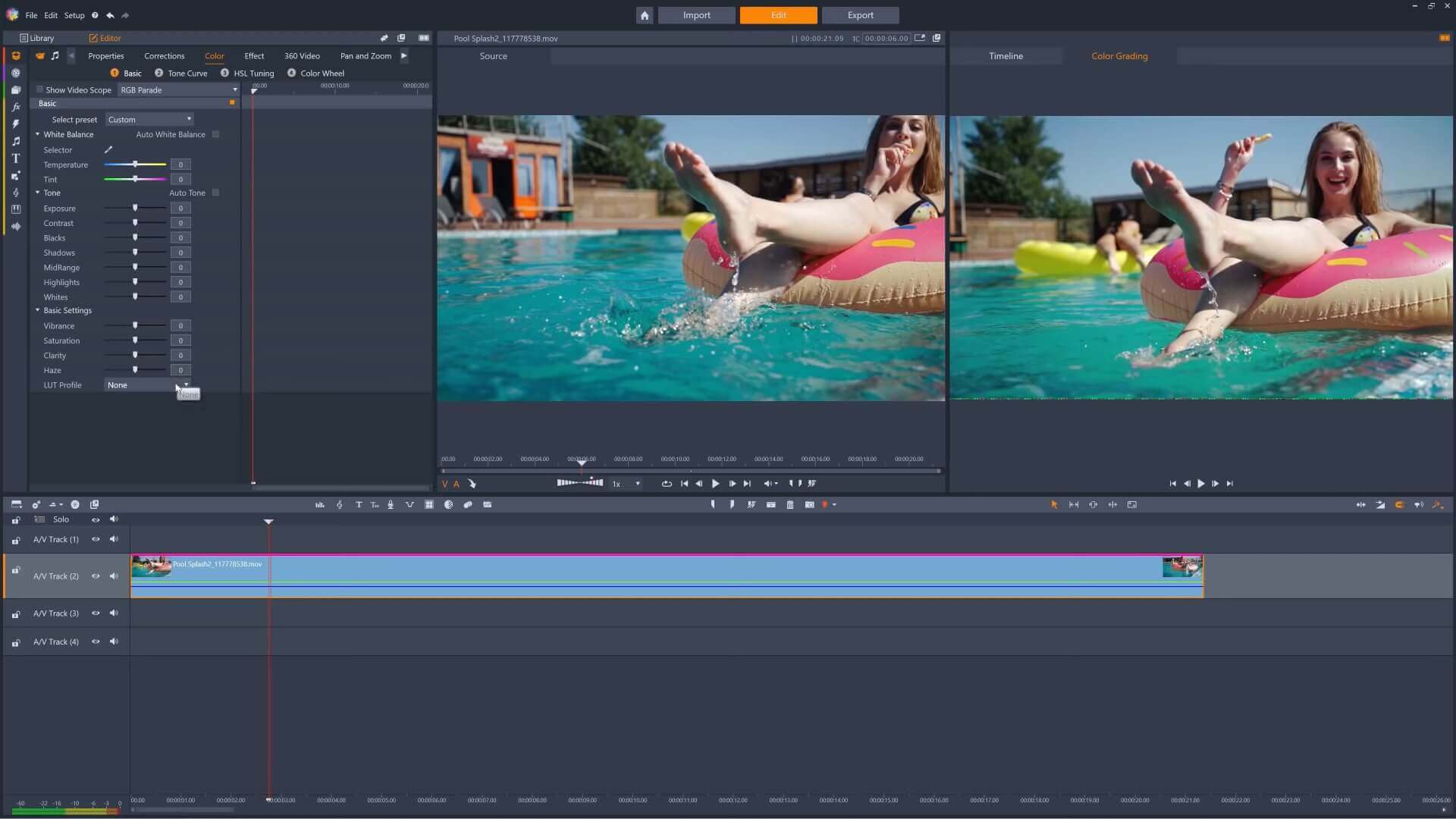
The Studio 25 is the basic version of the software and costs $59.95. The other two advanced versions: Studio 25 Plus and Studio 25 Ultimate, cost $99.95, and $129.95, respectively. There are no monthly or yearly subscriptions. You pay once, and you can use the software as long as you want.
The top-tier version, Studio 25 Ultimate, includes all the features of Studio 25 and Studio 25 Plus. These are:
- Editing across unlimited tracks
- 8K Import
- Advanced Color Grading
- Multi-camera editing for six cameras
- 100+ MyDVD menu templates
- Keyframe controls
- Motion Tracking with Mosaic Blur
Part 1: Best Alternative - Wondershare Filmora for Mac
With Wondershare Filmora for Mac, you can create great-looking movies on your computer. The software supports various media files and gives access to many sample data and multiple video editing options. You will be able to export the final product in various output formats without any loss of quality.
One unique feature of Filmora for Mac is sharing video clips directly to YouTube, Vimeo, or Facebook from the interface. Other notable features include motion tracking, keyframing, creating fun clips with effects, filters, titles, creating custom backgrounds or special effects with green screen, motion elements, cropping videos for different aspect ratios, color matching, auto reframing, audio ducking, and more.
Editing and previewing your video clips in Filmora is a breeze because of exclusive features specially designed for Mac computers. For instance, hardware acceleration makes editing videos faster and smoother on Macs than ever before. Moreover, the Touch Bar has full support so that you can view your footage much easier when scrolling through the timeline.
Part 2: Top 3 Studio for Mac Alternatives
1. Final Cut Pro
Final Cut Pro is a professional video editing software from Apple for anybody looking for a more powerful video editor for their Macs than the included iMovie. The software is also an excellent alternative for professionals creating content for TV and cinema. The latest version runs natively on M1 chip; you can expect apparent video editing improvements.
New features include transcoding media files automatically when copying or consolidating projects and downloadable user guides. Other highlighted recent features include Smart Conform, stabilization for 360-degree videos, performance improvements with RED and Canon RAW files, Inspector panel improvements, and audio crossfades.
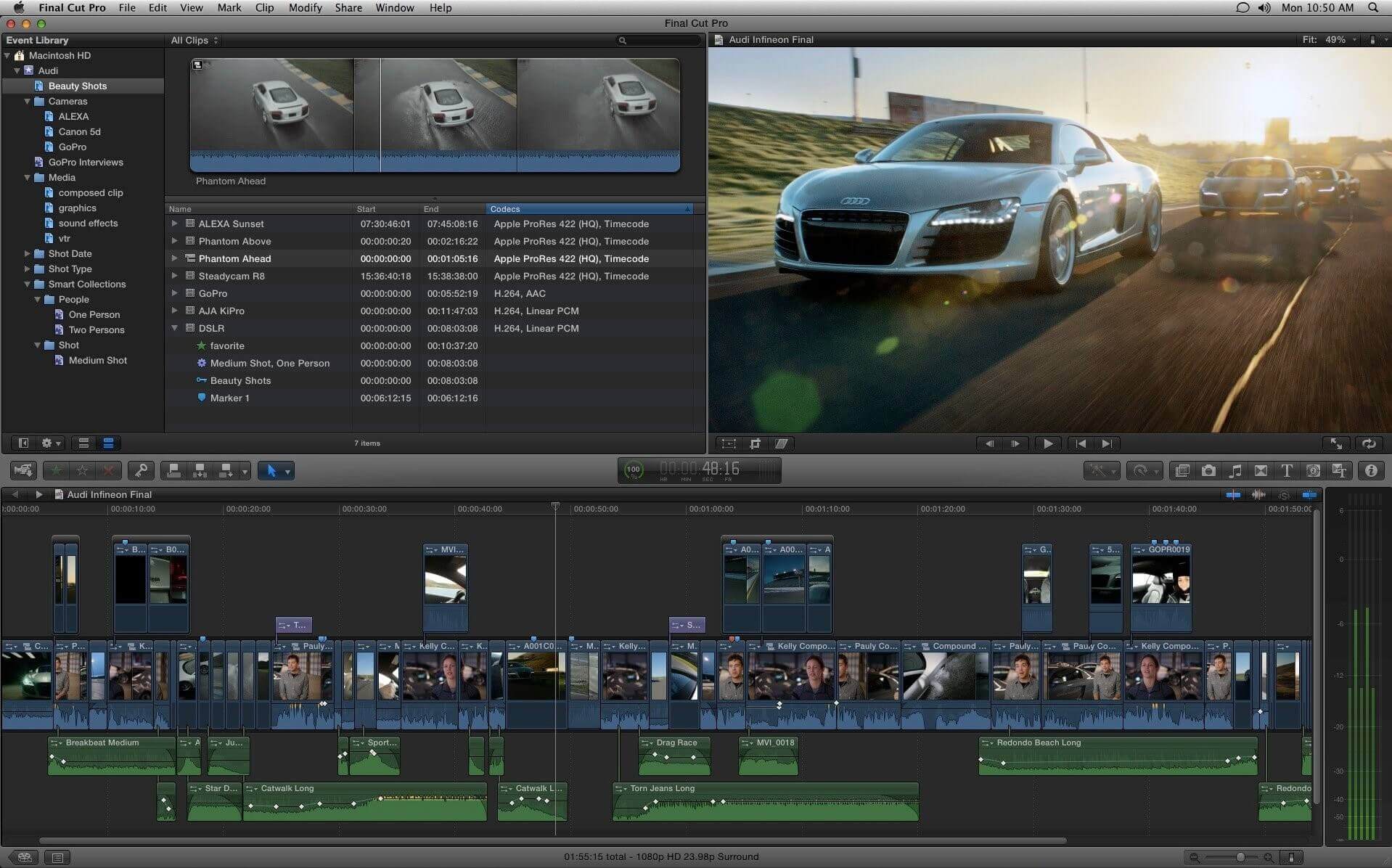
Price: $299 (onetime payment, no subscription)
Pros:
- Fast and superb performance
- Works perfectly with Apple computers
- 360-degree video and HDR Support
- Multicam support
Cons:
- Lacks motion tracking and stabilization for 360-degree videos
- Integration with Adobe software seems problematic
2. Lightworks
Another free video editing software that works as a good replacement for pinnacle studio for Mac is Lightworks. It’s packed with many useful features, and although there is paid version, the free version has all the bells and whistles needed for beginners.
However, if you’re working with 4K videos for YouTube or Vimeo—you need to get the paid version of Lightworks as this feature isn’t available in the free version. The paid version costs $25 a month. The free version includes multi-cam support, high-precision video trimming, video exports at 720p, and support for most video formats.
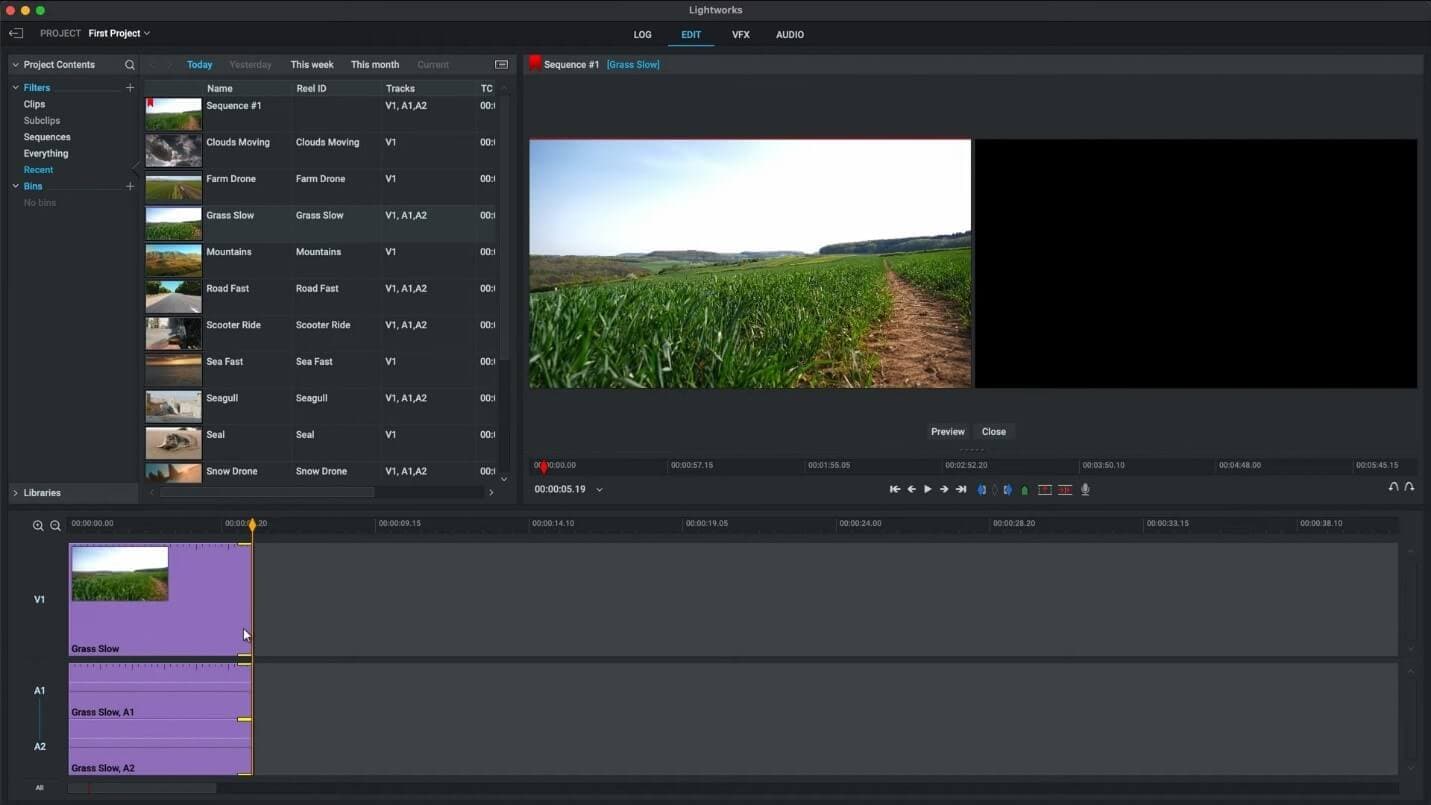
Price: $25/month
Pros:
- Has many video tutorials
- Intuitive interface and easy to use
- The free version is ideal for beginners
Cons:
- No 4K video support in the free version
- Lacks predefined filters and effects
3. OpenShot
With easy-to-use features, a simple interface, and real-time previews for transitions between clips, unlimited layers, and audio mixing capabilities, OpenShot is one of the top free video editing software around. One of the best things about OpenShot is that its interface allows for easy-to-use drag and drop features. If you’re a Mac user and looking for a free, open-source video editor that packs more features than iMovie—OpenShot is a great alternative you can’t miss.
With OpenShot’s special effects engine, users can modify, reverse, slow up or slow down videos, and preview projects in real-time. Furthermore, other standard features of OpenShot include composition, image overlays, clip resizing, trimming, snapping, scaling, watermarks, video transitions, title templates, creating personalized SVG vector titles, desktop integration, adjusting fonts, colors, 3D animated titles, and more.
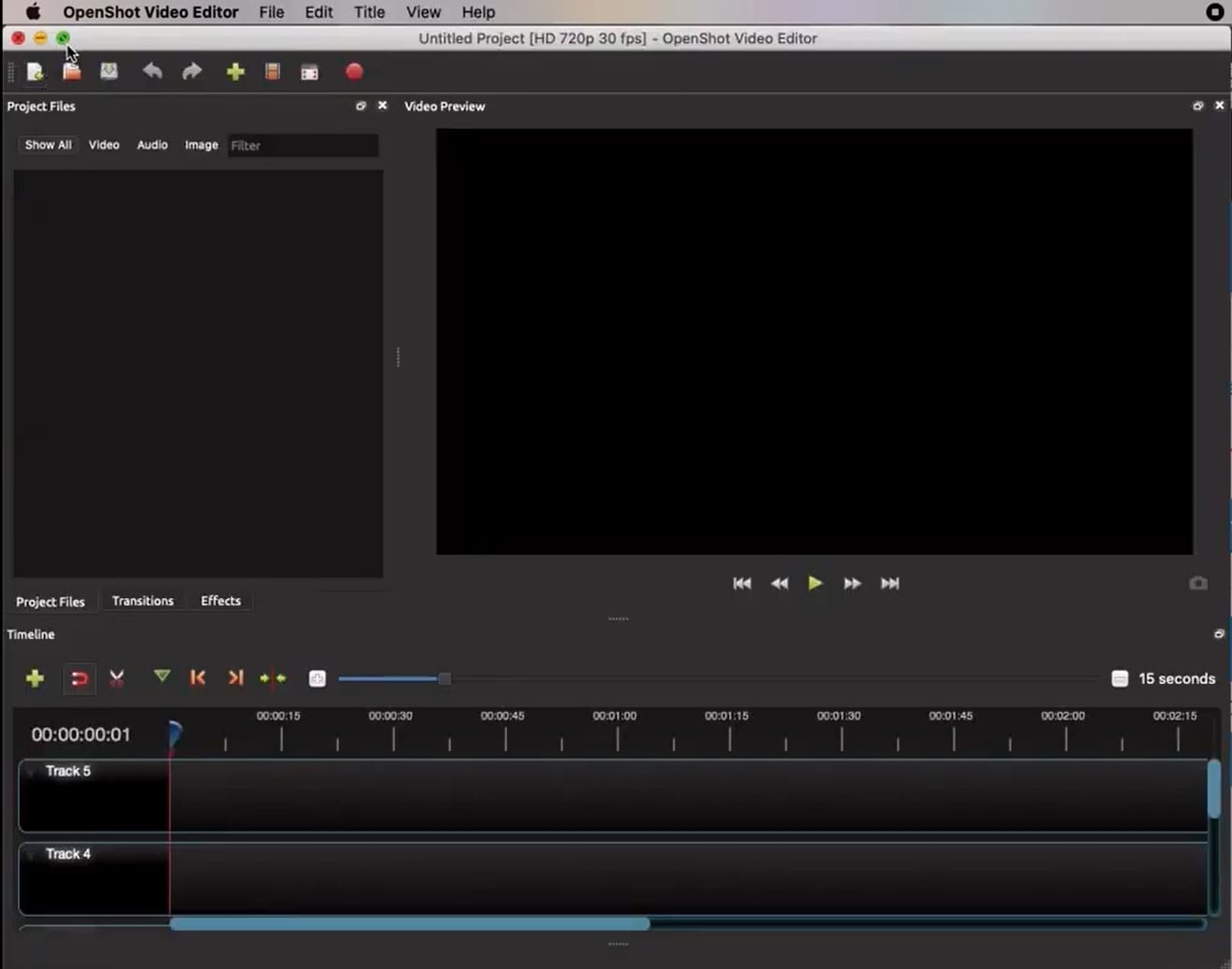
Price: Free, Open Source
Pros:
- Ideal for beginners
- Unlimited layers
- Professional transitions and effects
- Runs on entry-levels hardware
Cons
- Exporting videos isn’t the fastest
Conclusion
Studio is a video editor that works well on Windows or Linux computers but lacks support for Macs. This article lists some great options as Studio alternatives on macOS, including Wondershare Filmora for Mac. We think this would be your best pick, given how easy-to-use this program will be, even if you are new to editing videos. Besides, there isn’t much learning curve here due to the software’s intuitive interface and amazing functionalities. And Wondershare Filmora for Mac is the one that can satisfy amateurs and professionals!

Shanoon Cox
Shanoon Cox is a writer and a lover of all things video.
Follow @Shanoon Cox
Shanoon Cox
Mar 27, 2024• Proven solutions
Studio is a video editing software for Windows. There is no version of Studio that runs on Macs, but don’t fret! Check our recommendations below to find your best bet in terms of alternative options that will successfully edit videos on macOS as well.
Studio is designed for anyone new to video editing as well as professionals. believes that there is no one-size-fits-all. There are three tiers of Studio that are designed suited to suit each individual’s editing needs. Studio comes in three plans: Studio 25, Studio 25 Plus, and Studio 25 Ultimate.

The Studio 25 is the basic version of the software and costs $59.95. The other two advanced versions: Studio 25 Plus and Studio 25 Ultimate, cost $99.95, and $129.95, respectively. There are no monthly or yearly subscriptions. You pay once, and you can use the software as long as you want.
The top-tier version, Studio 25 Ultimate, includes all the features of Studio 25 and Studio 25 Plus. These are:
- Editing across unlimited tracks
- 8K Import
- Advanced Color Grading
- Multi-camera editing for six cameras
- 100+ MyDVD menu templates
- Keyframe controls
- Motion Tracking with Mosaic Blur
Part 1: Best Alternative - Wondershare Filmora for Mac
With Wondershare Filmora for Mac, you can create great-looking movies on your computer. The software supports various media files and gives access to many sample data and multiple video editing options. You will be able to export the final product in various output formats without any loss of quality.
One unique feature of Filmora for Mac is sharing video clips directly to YouTube, Vimeo, or Facebook from the interface. Other notable features include motion tracking, keyframing, creating fun clips with effects, filters, titles, creating custom backgrounds or special effects with green screen, motion elements, cropping videos for different aspect ratios, color matching, auto reframing, audio ducking, and more.
Editing and previewing your video clips in Filmora is a breeze because of exclusive features specially designed for Mac computers. For instance, hardware acceleration makes editing videos faster and smoother on Macs than ever before. Moreover, the Touch Bar has full support so that you can view your footage much easier when scrolling through the timeline.
Part 2: Top 3 Studio for Mac Alternatives
1. Final Cut Pro
Final Cut Pro is a professional video editing software from Apple for anybody looking for a more powerful video editor for their Macs than the included iMovie. The software is also an excellent alternative for professionals creating content for TV and cinema. The latest version runs natively on M1 chip; you can expect apparent video editing improvements.
New features include transcoding media files automatically when copying or consolidating projects and downloadable user guides. Other highlighted recent features include Smart Conform, stabilization for 360-degree videos, performance improvements with RED and Canon RAW files, Inspector panel improvements, and audio crossfades.

Price: $299 (onetime payment, no subscription)
Pros:
- Fast and superb performance
- Works perfectly with Apple computers
- 360-degree video and HDR Support
- Multicam support
Cons:
- Lacks motion tracking and stabilization for 360-degree videos
- Integration with Adobe software seems problematic
2. Lightworks
Another free video editing software that works as a good replacement for pinnacle studio for Mac is Lightworks. It’s packed with many useful features, and although there is paid version, the free version has all the bells and whistles needed for beginners.
However, if you’re working with 4K videos for YouTube or Vimeo—you need to get the paid version of Lightworks as this feature isn’t available in the free version. The paid version costs $25 a month. The free version includes multi-cam support, high-precision video trimming, video exports at 720p, and support for most video formats.

Price: $25/month
Pros:
- Has many video tutorials
- Intuitive interface and easy to use
- The free version is ideal for beginners
Cons:
- No 4K video support in the free version
- Lacks predefined filters and effects
3. OpenShot
With easy-to-use features, a simple interface, and real-time previews for transitions between clips, unlimited layers, and audio mixing capabilities, OpenShot is one of the top free video editing software around. One of the best things about OpenShot is that its interface allows for easy-to-use drag and drop features. If you’re a Mac user and looking for a free, open-source video editor that packs more features than iMovie—OpenShot is a great alternative you can’t miss.
With OpenShot’s special effects engine, users can modify, reverse, slow up or slow down videos, and preview projects in real-time. Furthermore, other standard features of OpenShot include composition, image overlays, clip resizing, trimming, snapping, scaling, watermarks, video transitions, title templates, creating personalized SVG vector titles, desktop integration, adjusting fonts, colors, 3D animated titles, and more.

Price: Free, Open Source
Pros:
- Ideal for beginners
- Unlimited layers
- Professional transitions and effects
- Runs on entry-levels hardware
Cons
- Exporting videos isn’t the fastest
Conclusion
Studio is a video editor that works well on Windows or Linux computers but lacks support for Macs. This article lists some great options as Studio alternatives on macOS, including Wondershare Filmora for Mac. We think this would be your best pick, given how easy-to-use this program will be, even if you are new to editing videos. Besides, there isn’t much learning curve here due to the software’s intuitive interface and amazing functionalities. And Wondershare Filmora for Mac is the one that can satisfy amateurs and professionals!

Shanoon Cox
Shanoon Cox is a writer and a lover of all things video.
Follow @Shanoon Cox
Shanoon Cox
Mar 27, 2024• Proven solutions
Studio is a video editing software for Windows. There is no version of Studio that runs on Macs, but don’t fret! Check our recommendations below to find your best bet in terms of alternative options that will successfully edit videos on macOS as well.
Studio is designed for anyone new to video editing as well as professionals. believes that there is no one-size-fits-all. There are three tiers of Studio that are designed suited to suit each individual’s editing needs. Studio comes in three plans: Studio 25, Studio 25 Plus, and Studio 25 Ultimate.

The Studio 25 is the basic version of the software and costs $59.95. The other two advanced versions: Studio 25 Plus and Studio 25 Ultimate, cost $99.95, and $129.95, respectively. There are no monthly or yearly subscriptions. You pay once, and you can use the software as long as you want.
The top-tier version, Studio 25 Ultimate, includes all the features of Studio 25 and Studio 25 Plus. These are:
- Editing across unlimited tracks
- 8K Import
- Advanced Color Grading
- Multi-camera editing for six cameras
- 100+ MyDVD menu templates
- Keyframe controls
- Motion Tracking with Mosaic Blur
Part 1: Best Alternative - Wondershare Filmora for Mac
With Wondershare Filmora for Mac, you can create great-looking movies on your computer. The software supports various media files and gives access to many sample data and multiple video editing options. You will be able to export the final product in various output formats without any loss of quality.
One unique feature of Filmora for Mac is sharing video clips directly to YouTube, Vimeo, or Facebook from the interface. Other notable features include motion tracking, keyframing, creating fun clips with effects, filters, titles, creating custom backgrounds or special effects with green screen, motion elements, cropping videos for different aspect ratios, color matching, auto reframing, audio ducking, and more.
Editing and previewing your video clips in Filmora is a breeze because of exclusive features specially designed for Mac computers. For instance, hardware acceleration makes editing videos faster and smoother on Macs than ever before. Moreover, the Touch Bar has full support so that you can view your footage much easier when scrolling through the timeline.
Part 2: Top 3 Studio for Mac Alternatives
1. Final Cut Pro
Final Cut Pro is a professional video editing software from Apple for anybody looking for a more powerful video editor for their Macs than the included iMovie. The software is also an excellent alternative for professionals creating content for TV and cinema. The latest version runs natively on M1 chip; you can expect apparent video editing improvements.
New features include transcoding media files automatically when copying or consolidating projects and downloadable user guides. Other highlighted recent features include Smart Conform, stabilization for 360-degree videos, performance improvements with RED and Canon RAW files, Inspector panel improvements, and audio crossfades.

Price: $299 (onetime payment, no subscription)
Pros:
- Fast and superb performance
- Works perfectly with Apple computers
- 360-degree video and HDR Support
- Multicam support
Cons:
- Lacks motion tracking and stabilization for 360-degree videos
- Integration with Adobe software seems problematic
2. Lightworks
Another free video editing software that works as a good replacement for pinnacle studio for Mac is Lightworks. It’s packed with many useful features, and although there is paid version, the free version has all the bells and whistles needed for beginners.
However, if you’re working with 4K videos for YouTube or Vimeo—you need to get the paid version of Lightworks as this feature isn’t available in the free version. The paid version costs $25 a month. The free version includes multi-cam support, high-precision video trimming, video exports at 720p, and support for most video formats.

Price: $25/month
Pros:
- Has many video tutorials
- Intuitive interface and easy to use
- The free version is ideal for beginners
Cons:
- No 4K video support in the free version
- Lacks predefined filters and effects
3. OpenShot
With easy-to-use features, a simple interface, and real-time previews for transitions between clips, unlimited layers, and audio mixing capabilities, OpenShot is one of the top free video editing software around. One of the best things about OpenShot is that its interface allows for easy-to-use drag and drop features. If you’re a Mac user and looking for a free, open-source video editor that packs more features than iMovie—OpenShot is a great alternative you can’t miss.
With OpenShot’s special effects engine, users can modify, reverse, slow up or slow down videos, and preview projects in real-time. Furthermore, other standard features of OpenShot include composition, image overlays, clip resizing, trimming, snapping, scaling, watermarks, video transitions, title templates, creating personalized SVG vector titles, desktop integration, adjusting fonts, colors, 3D animated titles, and more.

Price: Free, Open Source
Pros:
- Ideal for beginners
- Unlimited layers
- Professional transitions and effects
- Runs on entry-levels hardware
Cons
- Exporting videos isn’t the fastest
Conclusion
Studio is a video editor that works well on Windows or Linux computers but lacks support for Macs. This article lists some great options as Studio alternatives on macOS, including Wondershare Filmora for Mac. We think this would be your best pick, given how easy-to-use this program will be, even if you are new to editing videos. Besides, there isn’t much learning curve here due to the software’s intuitive interface and amazing functionalities. And Wondershare Filmora for Mac is the one that can satisfy amateurs and professionals!

Shanoon Cox
Shanoon Cox is a writer and a lover of all things video.
Follow @Shanoon Cox
Shanoon Cox
Mar 27, 2024• Proven solutions
Studio is a video editing software for Windows. There is no version of Studio that runs on Macs, but don’t fret! Check our recommendations below to find your best bet in terms of alternative options that will successfully edit videos on macOS as well.
Studio is designed for anyone new to video editing as well as professionals. believes that there is no one-size-fits-all. There are three tiers of Studio that are designed suited to suit each individual’s editing needs. Studio comes in three plans: Studio 25, Studio 25 Plus, and Studio 25 Ultimate.

The Studio 25 is the basic version of the software and costs $59.95. The other two advanced versions: Studio 25 Plus and Studio 25 Ultimate, cost $99.95, and $129.95, respectively. There are no monthly or yearly subscriptions. You pay once, and you can use the software as long as you want.
The top-tier version, Studio 25 Ultimate, includes all the features of Studio 25 and Studio 25 Plus. These are:
- Editing across unlimited tracks
- 8K Import
- Advanced Color Grading
- Multi-camera editing for six cameras
- 100+ MyDVD menu templates
- Keyframe controls
- Motion Tracking with Mosaic Blur
Part 1: Best Alternative - Wondershare Filmora for Mac
With Wondershare Filmora for Mac, you can create great-looking movies on your computer. The software supports various media files and gives access to many sample data and multiple video editing options. You will be able to export the final product in various output formats without any loss of quality.
One unique feature of Filmora for Mac is sharing video clips directly to YouTube, Vimeo, or Facebook from the interface. Other notable features include motion tracking, keyframing, creating fun clips with effects, filters, titles, creating custom backgrounds or special effects with green screen, motion elements, cropping videos for different aspect ratios, color matching, auto reframing, audio ducking, and more.
Editing and previewing your video clips in Filmora is a breeze because of exclusive features specially designed for Mac computers. For instance, hardware acceleration makes editing videos faster and smoother on Macs than ever before. Moreover, the Touch Bar has full support so that you can view your footage much easier when scrolling through the timeline.
Part 2: Top 3 Studio for Mac Alternatives
1. Final Cut Pro
Final Cut Pro is a professional video editing software from Apple for anybody looking for a more powerful video editor for their Macs than the included iMovie. The software is also an excellent alternative for professionals creating content for TV and cinema. The latest version runs natively on M1 chip; you can expect apparent video editing improvements.
New features include transcoding media files automatically when copying or consolidating projects and downloadable user guides. Other highlighted recent features include Smart Conform, stabilization for 360-degree videos, performance improvements with RED and Canon RAW files, Inspector panel improvements, and audio crossfades.

Price: $299 (onetime payment, no subscription)
Pros:
- Fast and superb performance
- Works perfectly with Apple computers
- 360-degree video and HDR Support
- Multicam support
Cons:
- Lacks motion tracking and stabilization for 360-degree videos
- Integration with Adobe software seems problematic
2. Lightworks
Another free video editing software that works as a good replacement for pinnacle studio for Mac is Lightworks. It’s packed with many useful features, and although there is paid version, the free version has all the bells and whistles needed for beginners.
However, if you’re working with 4K videos for YouTube or Vimeo—you need to get the paid version of Lightworks as this feature isn’t available in the free version. The paid version costs $25 a month. The free version includes multi-cam support, high-precision video trimming, video exports at 720p, and support for most video formats.

Price: $25/month
Pros:
- Has many video tutorials
- Intuitive interface and easy to use
- The free version is ideal for beginners
Cons:
- No 4K video support in the free version
- Lacks predefined filters and effects
3. OpenShot
With easy-to-use features, a simple interface, and real-time previews for transitions between clips, unlimited layers, and audio mixing capabilities, OpenShot is one of the top free video editing software around. One of the best things about OpenShot is that its interface allows for easy-to-use drag and drop features. If you’re a Mac user and looking for a free, open-source video editor that packs more features than iMovie—OpenShot is a great alternative you can’t miss.
With OpenShot’s special effects engine, users can modify, reverse, slow up or slow down videos, and preview projects in real-time. Furthermore, other standard features of OpenShot include composition, image overlays, clip resizing, trimming, snapping, scaling, watermarks, video transitions, title templates, creating personalized SVG vector titles, desktop integration, adjusting fonts, colors, 3D animated titles, and more.

Price: Free, Open Source
Pros:
- Ideal for beginners
- Unlimited layers
- Professional transitions and effects
- Runs on entry-levels hardware
Cons
- Exporting videos isn’t the fastest
Conclusion
Studio is a video editor that works well on Windows or Linux computers but lacks support for Macs. This article lists some great options as Studio alternatives on macOS, including Wondershare Filmora for Mac. We think this would be your best pick, given how easy-to-use this program will be, even if you are new to editing videos. Besides, there isn’t much learning curve here due to the software’s intuitive interface and amazing functionalities. And Wondershare Filmora for Mac is the one that can satisfy amateurs and professionals!

Shanoon Cox
Shanoon Cox is a writer and a lover of all things video.
Follow @Shanoon Cox
Fundamental Video Editing Software for All
New to video editing and don’t know how and where to edit videos, don’t have a media production, or can’t find a qualified video editor to film and produce your highlights? It’s all fine! The purpose of today’s article is to demonstrate that, with the correct video editor, you also can create slick, sophisticated video content—regardless of perception—and maintain your content marketing strategy ahead of the game.
In the coming year, over half of marketers will add YouTube and Facebook platforms for streaming video; one-third of all internet usage is spent viewing video; video will make for more than 80% of all internet traffic by 2019. 80% of the time! Let’s get started! From the most affordable (i.e., free!) for the beginners. Here is the best basic video editor that includes the features you’ll find handy in a video editor.
In this article
01 Best Basic Video Editors for Windows and Mac [Free and Paid]
02 Best Free Basic Video Editors Online
Part 1: Best Basic Video Editors for Windows and Mac [Free and Paid]
What should you do when you do not have access to a video studio or a team of video experts on staff to film and edit your videos? Do not be concerned!
Without the need for an in-house team or outsourcing your video brand awareness, it’s quicker than ever to make high-quality films on your own. Here are some of the top picks.
1. Windows Photos App
Microsoft Photos, a free digital viewer and video editor included with Windows 10 and Windows 11, provides capable visual effects and video enhancements, as well as techniques for organizing and editing videos, everything in a touch-friendly functionality. Windows 10/11 comes with the Photos app pre-integrated. You don’t have to do anything to obtain the app when you have Windows 10/11.
The free Microsoft photo and video editing app is a great choice for viewing, editing, and sharing digital photos and videos. As the name suggests, it’s for Windows users – a delight to use a picture and video-editing tool that’s simple to use, clean, and has all the functions you need for basic viewing and repairs. Obviously, a full-featured program like the Windows Photos App is required for advanced photo organizing, optimization, and effects.

Clips may be trimmed or divided, text can be added , motion or 3D effects can be applied, filters can be used, and the speed can be changed . It’s a huge array that allows you to create an interesting result. There are over 20 options for adding soundtracks at the backend at the top.
The Photos app features the Automatic Video tool which can create video automatically with the images or videos uploaded .
2. iMovie
Okay, so this one won’t actually apply to those of you who deal with computers, but we’d be negligent if we left it off the roster. Thanks to its high-class interface, it doesn’t get much nicer than Apple iMovie regarding elegance and beauty. It is only supported by macOS and iOS.
The ten high-fidelity filters in iMovie are among the best in the video editing game, and you can utilize AirDrop to instantly and smoothly transmit your video to your Mac when you’re filming on your iPhone or working on your iPad.
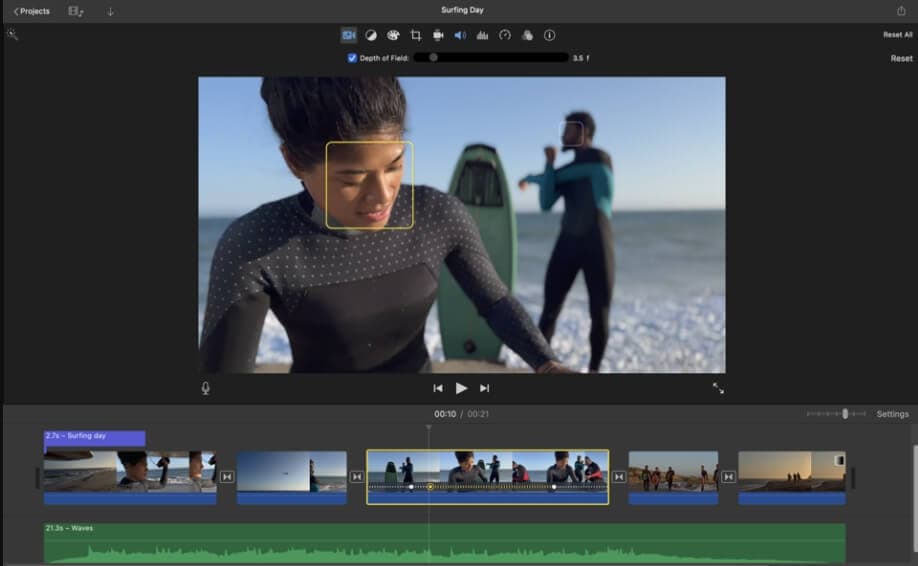
Green-screen , or “chroma-key,” is among iMovie’s most prized tools since it enables you to relocate your characters to exotic locations—say, Hawaii—at any time. Do you want to add “Somewhere Over the Rainbow” to the image? Because iMovie is integrated with iTunes and GarageBand, you may quickly add unique music and sounds to your movie. Once your video is finished, send it out into the world via iMessage, Facebook, YouTube, or any of iMovie’s numerous easily accessible venues.
Here are some tips and tricks in editing videos with iMovie, hope that will help you edit faster.
3. Apple Photos App
Apple Photos, a free app included with macOS and iOS, is our pick for the best basic video editing software for Mac and iOS users because it embodies the company’s concept of fun, easy-to-use software. The interface of Apple Photos is clean, straightforward, and direct, allowing you to express yourself using basic, uncomplicated shortcuts rather than the complex layers of capabilities seen in more feature-rich products. It is only supported by Apple devices only.
Years, collections, and Moments are used to arrange the videos. Only current devices with 64-bit CPUs, such as the iPhone 5s or above, is compliant with the new release of Apple Photos. The Apple Photos mobile application includes thumbnail sliders to switch numerous characteristics of a photo quickly, in addition to options for auto-enhance, red-eye removal, and crop/rotate.
In Adjust, for example, you may move an indicator over a thumbnail variant to change the video’s luminance or color intensity. The one-click filters are basic, but they can provide some interesting results. You can also use your fingers or type text on display to mark up a video, trim a video and save it as a short teaser, change the slow-motion segment of a film, and trim a video and save it as a new video.
Here are some of the best Apple video editing software , make sure to check it if you’re using a Mac.
4. Wondershare Filmora
In terms of video editors, Wondershare Filmora has long been a current favorite of several, particularly regular customers, due to its ease of use. You will be met with the interface where you will do all of your film editing production. You’ll note how clean, tidy, and uncomplicated it looks and seems at first sight.
For Win 7 or later (64-bit)
For macOS 10.12 or later
Library, Timeline, and Preview are the three options available in the interface. By heading to a specific section of the video on your timeline, double-clicking the area, waiting for it to pop into the preview segment, and then adding effects, transitions, audio, or stabilizing and correcting the video using any of the editing options that are available to you, you can perform simple video editing features.
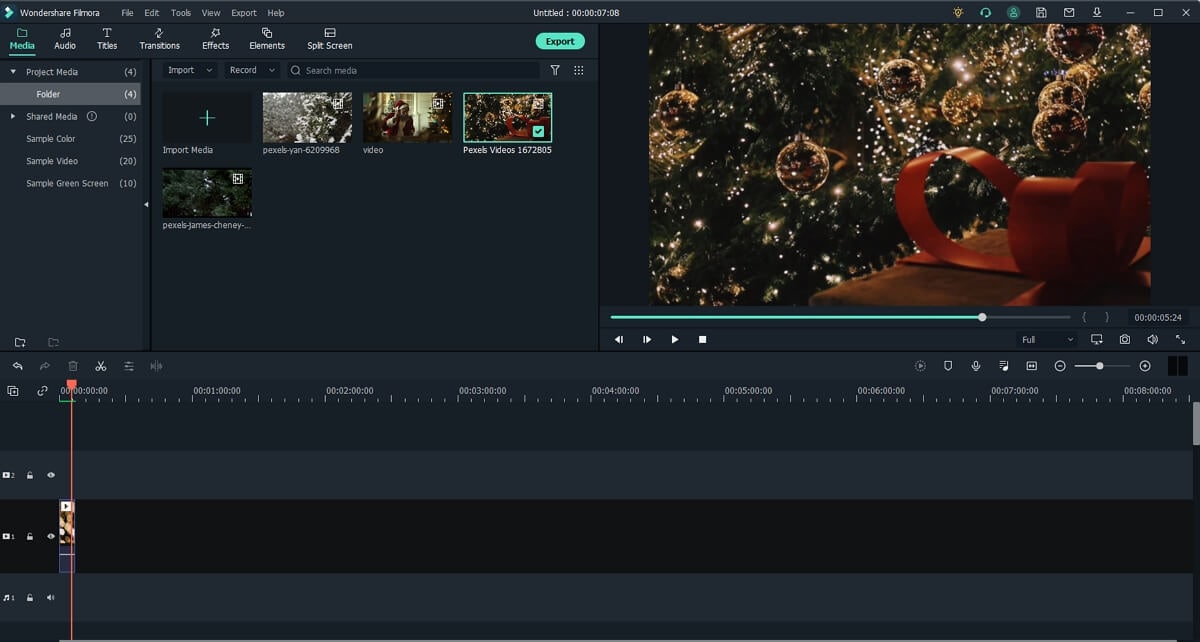
Additional but equally impressive functions include Lens Correction, Compositing, which applies blend modes to transitions and overlays; Drop Shadow, which applies shadows to images and words. And Auto Enhance, which significantly improves the quality of a substandard video.
5. Adobe Premiere Elements
Adobe Premiere Elements allows even beginner editors to create polished projects from their video sources. It’s an all-in-one video editing and video production software for those who love graphic user interfaces and straightforward layouts. You may sketch around an item or region within a video after adding an effect to it.
As the videos go on, Elements keeps track of this item and conceals the effect on it. You can brighten the sky, change the color of a driving car, and blur a person’s face. Guided Edits, which walk the user step-by-step through multiple things, is a fundamental component of Elements. It is supported by Windows
They help learn the ropes and gain confidence thanks to the user-friendly design. The current version of Premiere Elements has received some under-the-hood improvements, depending less on the CPU and more on the graphics card to improve results.

Part 2: Best Free Basic Video Editors Online
With the advent of social video sharing platforms such as YouTube, Vimeo, Instagram, and TikTok, video editing and production are no longer limited to experts. In this section of the article, we’ll go through the top 5 most highly suggested free online video editing tools that you may use.
The majority of the free basic video editor are beginner-friendly, so even if you’re new to video production, you can rapidly create a movie with these resources.
1. Clipchamp
Clipchamp is an excellent free online video editing program that includes a video compressor, converter, and webcam recorder in addition to video editing features. You can cut, crop, rotate and flip films with ease using drag-and-drop tools.
It allows you to upload media files from a local computer or online cloud storage sites like Google Drive, Dropbox, etc. You can also record the screen, camera or use the text to speech feature to generate audio sound.
Besides the basic video editing feature, this online video editor also provides some templates, stock video and music & sound effect libraries, which makes creating a video much easier. Furthermore, brightness, saturation, and contrast may all be easily adjusted. Transitions, text, overlays, and backdrops may all be added.
You may choose from a variety of aspect ratios, including 1:1, 9:16, 4:3, and 16:9, and it also comes with a built-in instruction to help you build a movie quickly. Plus, the software provides the editor with a large number of templates to pick from.
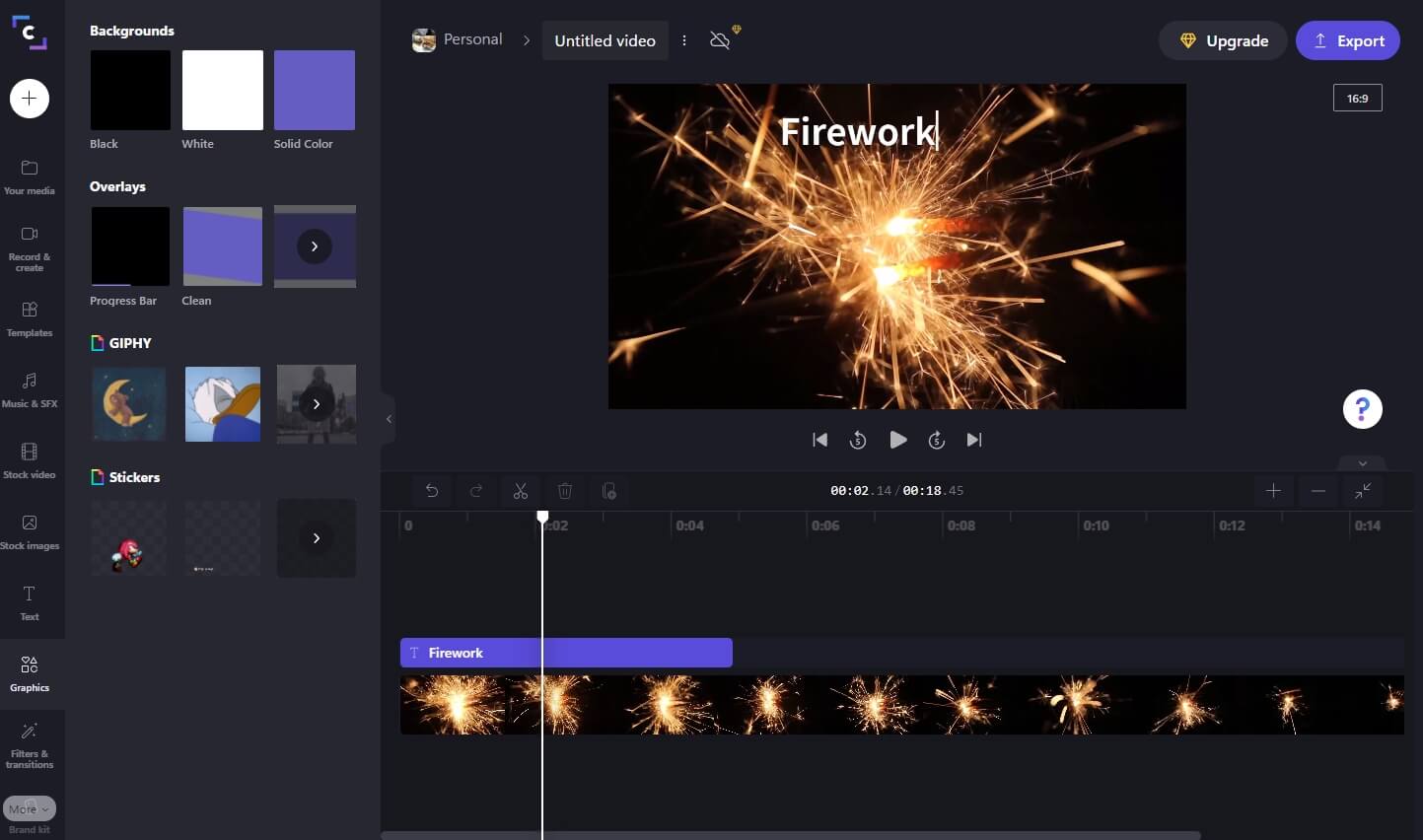
2. Magisto
Magisto is a fantastic online video creator who automatically transforms ordinary movies into gorgeous, dynamic videos and amazing social videos. It’s easy to use and speedy, with all the features you’d expect from software you paid your kidney for.

You may contribute photographs and videos to Magisto after signing up with your Facebook or Google+ account. Magisto also offers a variety of video themes for a variety of sectors, including birthday wishes, weddings, promotions, announcements, and inspiration. Select from trendy, family, business, social, seasonal, fun, and clean editing themes.
3. Kizoa
Kizoa is well-known for its extensive transition effects, which may help you create professional-looking films quickly. Kizoa also offers 4K UHD videos in various aspect ratios, including 16:9, 4:3, 3:2, 1:1, and 9:16, 3:4, and 2:3 portraits. That’s not even taking into account the software’s numerous templates.
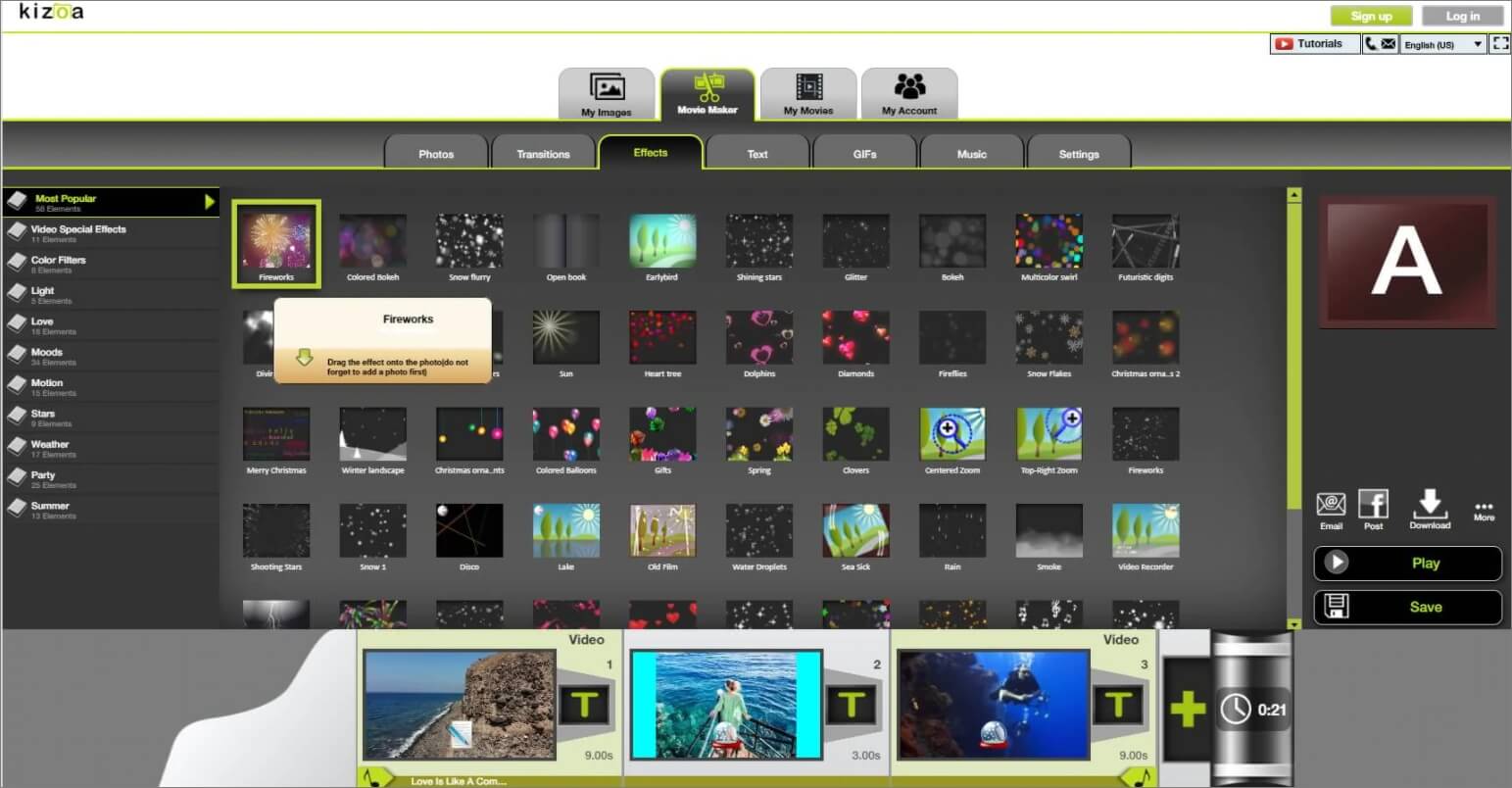
Kizoa’s library has a large number of animations and effects which can be used to adapt films to meet the demands of certain editing tasks. Many aspects of video clips will be considerably easier to customize, such as position, size, length, and timing. Because there is no need to log in to obtain all of these amazing features, most pros and novices prefer to utilize Kizoa for their daily requirements.
4. Canva
Another one on our list is the Canva , which is as easy and simpler to use as the rest of these. The interface on a computer’s web browser is quite straightforward, with a sidebar on the left-side guiding you through all of the stages required to complete your work. You may choose from a variety of templates. They’re divided into categories like Education, Reviews, Explainer, Sale, Fashion, Slideshow, YouTube into, and Outro, and so on.
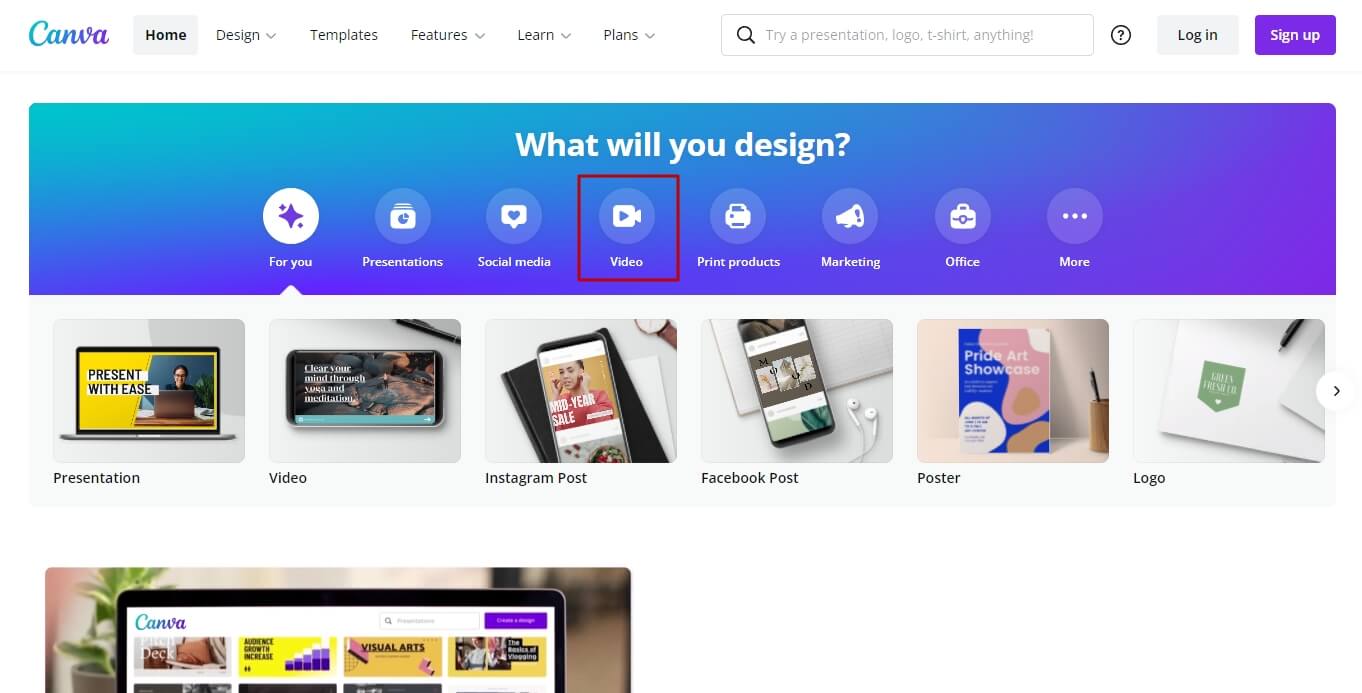
There are dozens of templates to pick from, with some appearing in many categories. Canva makes use of layers to allow things to be put in front of and behind each other. You may view and adjust that function by clicking the ‘Position’ option. Transparency, filters, color tweaks, cut, and flip are some of the other options available.
5. Adobe Spark
Adobe Spark , like Canva, is a video design platform. It enables you to generate a variety of images and social media material for professional or personal usage. Adobe Spark’s layout and usability will appeal to you. The primary interface, which appears before you use the editor, is straightforward.

Adobe Spark includes a vast library of templates when you’re looking for ideas or motivation for your creations. For organizations who wish to maintain a strong brand image in their material, the Brand area is a must-have element. You may develop new brands with the corporate logo, color palette, and typefaces as the starting point. Adobe Spark features a separate project tab that stores all of your work in one place.
Conclusion
Well, there you have it – the best basic video editors for beginners. Video editing has grown by ten folds from where it was five or six years ago. Almost anyone can edit a video to an extent. But what takes them to the next level is the use of efficient, effective, and productive software in place to do almost any kind of video editing. If you don’t want to install any software on your computer, you can try these online video editors or the preset video makers; if you want to improve the video quality, desktop software is recommended.
02 Best Free Basic Video Editors Online
Part 1: Best Basic Video Editors for Windows and Mac [Free and Paid]
What should you do when you do not have access to a video studio or a team of video experts on staff to film and edit your videos? Do not be concerned!
Without the need for an in-house team or outsourcing your video brand awareness, it’s quicker than ever to make high-quality films on your own. Here are some of the top picks.
1. Windows Photos App
Microsoft Photos, a free digital viewer and video editor included with Windows 10 and Windows 11, provides capable visual effects and video enhancements, as well as techniques for organizing and editing videos, everything in a touch-friendly functionality. Windows 10/11 comes with the Photos app pre-integrated. You don’t have to do anything to obtain the app when you have Windows 10/11.
The free Microsoft photo and video editing app is a great choice for viewing, editing, and sharing digital photos and videos. As the name suggests, it’s for Windows users – a delight to use a picture and video-editing tool that’s simple to use, clean, and has all the functions you need for basic viewing and repairs. Obviously, a full-featured program like the Windows Photos App is required for advanced photo organizing, optimization, and effects.

Clips may be trimmed or divided, text can be added , motion or 3D effects can be applied, filters can be used, and the speed can be changed . It’s a huge array that allows you to create an interesting result. There are over 20 options for adding soundtracks at the backend at the top.
The Photos app features the Automatic Video tool which can create video automatically with the images or videos uploaded .
2. iMovie
Okay, so this one won’t actually apply to those of you who deal with computers, but we’d be negligent if we left it off the roster. Thanks to its high-class interface, it doesn’t get much nicer than Apple iMovie regarding elegance and beauty. It is only supported by macOS and iOS.
The ten high-fidelity filters in iMovie are among the best in the video editing game, and you can utilize AirDrop to instantly and smoothly transmit your video to your Mac when you’re filming on your iPhone or working on your iPad.

Green-screen , or “chroma-key,” is among iMovie’s most prized tools since it enables you to relocate your characters to exotic locations—say, Hawaii—at any time. Do you want to add “Somewhere Over the Rainbow” to the image? Because iMovie is integrated with iTunes and GarageBand, you may quickly add unique music and sounds to your movie. Once your video is finished, send it out into the world via iMessage, Facebook, YouTube, or any of iMovie’s numerous easily accessible venues.
Here are some tips and tricks in editing videos with iMovie, hope that will help you edit faster.
3. Apple Photos App
Apple Photos, a free app included with macOS and iOS, is our pick for the best basic video editing software for Mac and iOS users because it embodies the company’s concept of fun, easy-to-use software. The interface of Apple Photos is clean, straightforward, and direct, allowing you to express yourself using basic, uncomplicated shortcuts rather than the complex layers of capabilities seen in more feature-rich products. It is only supported by Apple devices only.
Years, collections, and Moments are used to arrange the videos. Only current devices with 64-bit CPUs, such as the iPhone 5s or above, is compliant with the new release of Apple Photos. The Apple Photos mobile application includes thumbnail sliders to switch numerous characteristics of a photo quickly, in addition to options for auto-enhance, red-eye removal, and crop/rotate.
In Adjust, for example, you may move an indicator over a thumbnail variant to change the video’s luminance or color intensity. The one-click filters are basic, but they can provide some interesting results. You can also use your fingers or type text on display to mark up a video, trim a video and save it as a short teaser, change the slow-motion segment of a film, and trim a video and save it as a new video.
Here are some of the best Apple video editing software , make sure to check it if you’re using a Mac.
4. Wondershare Filmora
In terms of video editors, Wondershare Filmora has long been a current favorite of several, particularly regular customers, due to its ease of use. You will be met with the interface where you will do all of your film editing production. You’ll note how clean, tidy, and uncomplicated it looks and seems at first sight.
For Win 7 or later (64-bit)
For macOS 10.12 or later
Library, Timeline, and Preview are the three options available in the interface. By heading to a specific section of the video on your timeline, double-clicking the area, waiting for it to pop into the preview segment, and then adding effects, transitions, audio, or stabilizing and correcting the video using any of the editing options that are available to you, you can perform simple video editing features.

Additional but equally impressive functions include Lens Correction, Compositing, which applies blend modes to transitions and overlays; Drop Shadow, which applies shadows to images and words. And Auto Enhance, which significantly improves the quality of a substandard video.
5. Adobe Premiere Elements
Adobe Premiere Elements allows even beginner editors to create polished projects from their video sources. It’s an all-in-one video editing and video production software for those who love graphic user interfaces and straightforward layouts. You may sketch around an item or region within a video after adding an effect to it.
As the videos go on, Elements keeps track of this item and conceals the effect on it. You can brighten the sky, change the color of a driving car, and blur a person’s face. Guided Edits, which walk the user step-by-step through multiple things, is a fundamental component of Elements. It is supported by Windows
They help learn the ropes and gain confidence thanks to the user-friendly design. The current version of Premiere Elements has received some under-the-hood improvements, depending less on the CPU and more on the graphics card to improve results.

Part 2: Best Free Basic Video Editors Online
With the advent of social video sharing platforms such as YouTube, Vimeo, Instagram, and TikTok, video editing and production are no longer limited to experts. In this section of the article, we’ll go through the top 5 most highly suggested free online video editing tools that you may use.
The majority of the free basic video editor are beginner-friendly, so even if you’re new to video production, you can rapidly create a movie with these resources.
1. Clipchamp
Clipchamp is an excellent free online video editing program that includes a video compressor, converter, and webcam recorder in addition to video editing features. You can cut, crop, rotate and flip films with ease using drag-and-drop tools.
It allows you to upload media files from a local computer or online cloud storage sites like Google Drive, Dropbox, etc. You can also record the screen, camera or use the text to speech feature to generate audio sound.
Besides the basic video editing feature, this online video editor also provides some templates, stock video and music & sound effect libraries, which makes creating a video much easier. Furthermore, brightness, saturation, and contrast may all be easily adjusted. Transitions, text, overlays, and backdrops may all be added.
You may choose from a variety of aspect ratios, including 1:1, 9:16, 4:3, and 16:9, and it also comes with a built-in instruction to help you build a movie quickly. Plus, the software provides the editor with a large number of templates to pick from.

2. Magisto
Magisto is a fantastic online video creator who automatically transforms ordinary movies into gorgeous, dynamic videos and amazing social videos. It’s easy to use and speedy, with all the features you’d expect from software you paid your kidney for.

You may contribute photographs and videos to Magisto after signing up with your Facebook or Google+ account. Magisto also offers a variety of video themes for a variety of sectors, including birthday wishes, weddings, promotions, announcements, and inspiration. Select from trendy, family, business, social, seasonal, fun, and clean editing themes.
3. Kizoa
Kizoa is well-known for its extensive transition effects, which may help you create professional-looking films quickly. Kizoa also offers 4K UHD videos in various aspect ratios, including 16:9, 4:3, 3:2, 1:1, and 9:16, 3:4, and 2:3 portraits. That’s not even taking into account the software’s numerous templates.

Kizoa’s library has a large number of animations and effects which can be used to adapt films to meet the demands of certain editing tasks. Many aspects of video clips will be considerably easier to customize, such as position, size, length, and timing. Because there is no need to log in to obtain all of these amazing features, most pros and novices prefer to utilize Kizoa for their daily requirements.
4. Canva
Another one on our list is the Canva , which is as easy and simpler to use as the rest of these. The interface on a computer’s web browser is quite straightforward, with a sidebar on the left-side guiding you through all of the stages required to complete your work. You may choose from a variety of templates. They’re divided into categories like Education, Reviews, Explainer, Sale, Fashion, Slideshow, YouTube into, and Outro, and so on.

There are dozens of templates to pick from, with some appearing in many categories. Canva makes use of layers to allow things to be put in front of and behind each other. You may view and adjust that function by clicking the ‘Position’ option. Transparency, filters, color tweaks, cut, and flip are some of the other options available.
5. Adobe Spark
Adobe Spark , like Canva, is a video design platform. It enables you to generate a variety of images and social media material for professional or personal usage. Adobe Spark’s layout and usability will appeal to you. The primary interface, which appears before you use the editor, is straightforward.

Adobe Spark includes a vast library of templates when you’re looking for ideas or motivation for your creations. For organizations who wish to maintain a strong brand image in their material, the Brand area is a must-have element. You may develop new brands with the corporate logo, color palette, and typefaces as the starting point. Adobe Spark features a separate project tab that stores all of your work in one place.
Conclusion
Well, there you have it – the best basic video editors for beginners. Video editing has grown by ten folds from where it was five or six years ago. Almost anyone can edit a video to an extent. But what takes them to the next level is the use of efficient, effective, and productive software in place to do almost any kind of video editing. If you don’t want to install any software on your computer, you can try these online video editors or the preset video makers; if you want to improve the video quality, desktop software is recommended.
02 Best Free Basic Video Editors Online
Part 1: Best Basic Video Editors for Windows and Mac [Free and Paid]
What should you do when you do not have access to a video studio or a team of video experts on staff to film and edit your videos? Do not be concerned!
Without the need for an in-house team or outsourcing your video brand awareness, it’s quicker than ever to make high-quality films on your own. Here are some of the top picks.
1. Windows Photos App
Microsoft Photos, a free digital viewer and video editor included with Windows 10 and Windows 11, provides capable visual effects and video enhancements, as well as techniques for organizing and editing videos, everything in a touch-friendly functionality. Windows 10/11 comes with the Photos app pre-integrated. You don’t have to do anything to obtain the app when you have Windows 10/11.
The free Microsoft photo and video editing app is a great choice for viewing, editing, and sharing digital photos and videos. As the name suggests, it’s for Windows users – a delight to use a picture and video-editing tool that’s simple to use, clean, and has all the functions you need for basic viewing and repairs. Obviously, a full-featured program like the Windows Photos App is required for advanced photo organizing, optimization, and effects.

Clips may be trimmed or divided, text can be added , motion or 3D effects can be applied, filters can be used, and the speed can be changed . It’s a huge array that allows you to create an interesting result. There are over 20 options for adding soundtracks at the backend at the top.
The Photos app features the Automatic Video tool which can create video automatically with the images or videos uploaded .
2. iMovie
Okay, so this one won’t actually apply to those of you who deal with computers, but we’d be negligent if we left it off the roster. Thanks to its high-class interface, it doesn’t get much nicer than Apple iMovie regarding elegance and beauty. It is only supported by macOS and iOS.
The ten high-fidelity filters in iMovie are among the best in the video editing game, and you can utilize AirDrop to instantly and smoothly transmit your video to your Mac when you’re filming on your iPhone or working on your iPad.

Green-screen , or “chroma-key,” is among iMovie’s most prized tools since it enables you to relocate your characters to exotic locations—say, Hawaii—at any time. Do you want to add “Somewhere Over the Rainbow” to the image? Because iMovie is integrated with iTunes and GarageBand, you may quickly add unique music and sounds to your movie. Once your video is finished, send it out into the world via iMessage, Facebook, YouTube, or any of iMovie’s numerous easily accessible venues.
Here are some tips and tricks in editing videos with iMovie, hope that will help you edit faster.
3. Apple Photos App
Apple Photos, a free app included with macOS and iOS, is our pick for the best basic video editing software for Mac and iOS users because it embodies the company’s concept of fun, easy-to-use software. The interface of Apple Photos is clean, straightforward, and direct, allowing you to express yourself using basic, uncomplicated shortcuts rather than the complex layers of capabilities seen in more feature-rich products. It is only supported by Apple devices only.
Years, collections, and Moments are used to arrange the videos. Only current devices with 64-bit CPUs, such as the iPhone 5s or above, is compliant with the new release of Apple Photos. The Apple Photos mobile application includes thumbnail sliders to switch numerous characteristics of a photo quickly, in addition to options for auto-enhance, red-eye removal, and crop/rotate.
In Adjust, for example, you may move an indicator over a thumbnail variant to change the video’s luminance or color intensity. The one-click filters are basic, but they can provide some interesting results. You can also use your fingers or type text on display to mark up a video, trim a video and save it as a short teaser, change the slow-motion segment of a film, and trim a video and save it as a new video.
Here are some of the best Apple video editing software , make sure to check it if you’re using a Mac.
4. Wondershare Filmora
In terms of video editors, Wondershare Filmora has long been a current favorite of several, particularly regular customers, due to its ease of use. You will be met with the interface where you will do all of your film editing production. You’ll note how clean, tidy, and uncomplicated it looks and seems at first sight.
For Win 7 or later (64-bit)
For macOS 10.12 or later
Library, Timeline, and Preview are the three options available in the interface. By heading to a specific section of the video on your timeline, double-clicking the area, waiting for it to pop into the preview segment, and then adding effects, transitions, audio, or stabilizing and correcting the video using any of the editing options that are available to you, you can perform simple video editing features.

Additional but equally impressive functions include Lens Correction, Compositing, which applies blend modes to transitions and overlays; Drop Shadow, which applies shadows to images and words. And Auto Enhance, which significantly improves the quality of a substandard video.
5. Adobe Premiere Elements
Adobe Premiere Elements allows even beginner editors to create polished projects from their video sources. It’s an all-in-one video editing and video production software for those who love graphic user interfaces and straightforward layouts. You may sketch around an item or region within a video after adding an effect to it.
As the videos go on, Elements keeps track of this item and conceals the effect on it. You can brighten the sky, change the color of a driving car, and blur a person’s face. Guided Edits, which walk the user step-by-step through multiple things, is a fundamental component of Elements. It is supported by Windows
They help learn the ropes and gain confidence thanks to the user-friendly design. The current version of Premiere Elements has received some under-the-hood improvements, depending less on the CPU and more on the graphics card to improve results.

Part 2: Best Free Basic Video Editors Online
With the advent of social video sharing platforms such as YouTube, Vimeo, Instagram, and TikTok, video editing and production are no longer limited to experts. In this section of the article, we’ll go through the top 5 most highly suggested free online video editing tools that you may use.
The majority of the free basic video editor are beginner-friendly, so even if you’re new to video production, you can rapidly create a movie with these resources.
1. Clipchamp
Clipchamp is an excellent free online video editing program that includes a video compressor, converter, and webcam recorder in addition to video editing features. You can cut, crop, rotate and flip films with ease using drag-and-drop tools.
It allows you to upload media files from a local computer or online cloud storage sites like Google Drive, Dropbox, etc. You can also record the screen, camera or use the text to speech feature to generate audio sound.
Besides the basic video editing feature, this online video editor also provides some templates, stock video and music & sound effect libraries, which makes creating a video much easier. Furthermore, brightness, saturation, and contrast may all be easily adjusted. Transitions, text, overlays, and backdrops may all be added.
You may choose from a variety of aspect ratios, including 1:1, 9:16, 4:3, and 16:9, and it also comes with a built-in instruction to help you build a movie quickly. Plus, the software provides the editor with a large number of templates to pick from.

2. Magisto
Magisto is a fantastic online video creator who automatically transforms ordinary movies into gorgeous, dynamic videos and amazing social videos. It’s easy to use and speedy, with all the features you’d expect from software you paid your kidney for.

You may contribute photographs and videos to Magisto after signing up with your Facebook or Google+ account. Magisto also offers a variety of video themes for a variety of sectors, including birthday wishes, weddings, promotions, announcements, and inspiration. Select from trendy, family, business, social, seasonal, fun, and clean editing themes.
3. Kizoa
Kizoa is well-known for its extensive transition effects, which may help you create professional-looking films quickly. Kizoa also offers 4K UHD videos in various aspect ratios, including 16:9, 4:3, 3:2, 1:1, and 9:16, 3:4, and 2:3 portraits. That’s not even taking into account the software’s numerous templates.

Kizoa’s library has a large number of animations and effects which can be used to adapt films to meet the demands of certain editing tasks. Many aspects of video clips will be considerably easier to customize, such as position, size, length, and timing. Because there is no need to log in to obtain all of these amazing features, most pros and novices prefer to utilize Kizoa for their daily requirements.
4. Canva
Another one on our list is the Canva , which is as easy and simpler to use as the rest of these. The interface on a computer’s web browser is quite straightforward, with a sidebar on the left-side guiding you through all of the stages required to complete your work. You may choose from a variety of templates. They’re divided into categories like Education, Reviews, Explainer, Sale, Fashion, Slideshow, YouTube into, and Outro, and so on.

There are dozens of templates to pick from, with some appearing in many categories. Canva makes use of layers to allow things to be put in front of and behind each other. You may view and adjust that function by clicking the ‘Position’ option. Transparency, filters, color tweaks, cut, and flip are some of the other options available.
5. Adobe Spark
Adobe Spark , like Canva, is a video design platform. It enables you to generate a variety of images and social media material for professional or personal usage. Adobe Spark’s layout and usability will appeal to you. The primary interface, which appears before you use the editor, is straightforward.

Adobe Spark includes a vast library of templates when you’re looking for ideas or motivation for your creations. For organizations who wish to maintain a strong brand image in their material, the Brand area is a must-have element. You may develop new brands with the corporate logo, color palette, and typefaces as the starting point. Adobe Spark features a separate project tab that stores all of your work in one place.
Conclusion
Well, there you have it – the best basic video editors for beginners. Video editing has grown by ten folds from where it was five or six years ago. Almost anyone can edit a video to an extent. But what takes them to the next level is the use of efficient, effective, and productive software in place to do almost any kind of video editing. If you don’t want to install any software on your computer, you can try these online video editors or the preset video makers; if you want to improve the video quality, desktop software is recommended.
02 Best Free Basic Video Editors Online
Part 1: Best Basic Video Editors for Windows and Mac [Free and Paid]
What should you do when you do not have access to a video studio or a team of video experts on staff to film and edit your videos? Do not be concerned!
Without the need for an in-house team or outsourcing your video brand awareness, it’s quicker than ever to make high-quality films on your own. Here are some of the top picks.
1. Windows Photos App
Microsoft Photos, a free digital viewer and video editor included with Windows 10 and Windows 11, provides capable visual effects and video enhancements, as well as techniques for organizing and editing videos, everything in a touch-friendly functionality. Windows 10/11 comes with the Photos app pre-integrated. You don’t have to do anything to obtain the app when you have Windows 10/11.
The free Microsoft photo and video editing app is a great choice for viewing, editing, and sharing digital photos and videos. As the name suggests, it’s for Windows users – a delight to use a picture and video-editing tool that’s simple to use, clean, and has all the functions you need for basic viewing and repairs. Obviously, a full-featured program like the Windows Photos App is required for advanced photo organizing, optimization, and effects.

Clips may be trimmed or divided, text can be added , motion or 3D effects can be applied, filters can be used, and the speed can be changed . It’s a huge array that allows you to create an interesting result. There are over 20 options for adding soundtracks at the backend at the top.
The Photos app features the Automatic Video tool which can create video automatically with the images or videos uploaded .
2. iMovie
Okay, so this one won’t actually apply to those of you who deal with computers, but we’d be negligent if we left it off the roster. Thanks to its high-class interface, it doesn’t get much nicer than Apple iMovie regarding elegance and beauty. It is only supported by macOS and iOS.
The ten high-fidelity filters in iMovie are among the best in the video editing game, and you can utilize AirDrop to instantly and smoothly transmit your video to your Mac when you’re filming on your iPhone or working on your iPad.

Green-screen , or “chroma-key,” is among iMovie’s most prized tools since it enables you to relocate your characters to exotic locations—say, Hawaii—at any time. Do you want to add “Somewhere Over the Rainbow” to the image? Because iMovie is integrated with iTunes and GarageBand, you may quickly add unique music and sounds to your movie. Once your video is finished, send it out into the world via iMessage, Facebook, YouTube, or any of iMovie’s numerous easily accessible venues.
Here are some tips and tricks in editing videos with iMovie, hope that will help you edit faster.
3. Apple Photos App
Apple Photos, a free app included with macOS and iOS, is our pick for the best basic video editing software for Mac and iOS users because it embodies the company’s concept of fun, easy-to-use software. The interface of Apple Photos is clean, straightforward, and direct, allowing you to express yourself using basic, uncomplicated shortcuts rather than the complex layers of capabilities seen in more feature-rich products. It is only supported by Apple devices only.
Years, collections, and Moments are used to arrange the videos. Only current devices with 64-bit CPUs, such as the iPhone 5s or above, is compliant with the new release of Apple Photos. The Apple Photos mobile application includes thumbnail sliders to switch numerous characteristics of a photo quickly, in addition to options for auto-enhance, red-eye removal, and crop/rotate.
In Adjust, for example, you may move an indicator over a thumbnail variant to change the video’s luminance or color intensity. The one-click filters are basic, but they can provide some interesting results. You can also use your fingers or type text on display to mark up a video, trim a video and save it as a short teaser, change the slow-motion segment of a film, and trim a video and save it as a new video.
Here are some of the best Apple video editing software , make sure to check it if you’re using a Mac.
4. Wondershare Filmora
In terms of video editors, Wondershare Filmora has long been a current favorite of several, particularly regular customers, due to its ease of use. You will be met with the interface where you will do all of your film editing production. You’ll note how clean, tidy, and uncomplicated it looks and seems at first sight.
For Win 7 or later (64-bit)
For macOS 10.12 or later
Library, Timeline, and Preview are the three options available in the interface. By heading to a specific section of the video on your timeline, double-clicking the area, waiting for it to pop into the preview segment, and then adding effects, transitions, audio, or stabilizing and correcting the video using any of the editing options that are available to you, you can perform simple video editing features.

Additional but equally impressive functions include Lens Correction, Compositing, which applies blend modes to transitions and overlays; Drop Shadow, which applies shadows to images and words. And Auto Enhance, which significantly improves the quality of a substandard video.
5. Adobe Premiere Elements
Adobe Premiere Elements allows even beginner editors to create polished projects from their video sources. It’s an all-in-one video editing and video production software for those who love graphic user interfaces and straightforward layouts. You may sketch around an item or region within a video after adding an effect to it.
As the videos go on, Elements keeps track of this item and conceals the effect on it. You can brighten the sky, change the color of a driving car, and blur a person’s face. Guided Edits, which walk the user step-by-step through multiple things, is a fundamental component of Elements. It is supported by Windows
They help learn the ropes and gain confidence thanks to the user-friendly design. The current version of Premiere Elements has received some under-the-hood improvements, depending less on the CPU and more on the graphics card to improve results.

Part 2: Best Free Basic Video Editors Online
With the advent of social video sharing platforms such as YouTube, Vimeo, Instagram, and TikTok, video editing and production are no longer limited to experts. In this section of the article, we’ll go through the top 5 most highly suggested free online video editing tools that you may use.
The majority of the free basic video editor are beginner-friendly, so even if you’re new to video production, you can rapidly create a movie with these resources.
1. Clipchamp
Clipchamp is an excellent free online video editing program that includes a video compressor, converter, and webcam recorder in addition to video editing features. You can cut, crop, rotate and flip films with ease using drag-and-drop tools.
It allows you to upload media files from a local computer or online cloud storage sites like Google Drive, Dropbox, etc. You can also record the screen, camera or use the text to speech feature to generate audio sound.
Besides the basic video editing feature, this online video editor also provides some templates, stock video and music & sound effect libraries, which makes creating a video much easier. Furthermore, brightness, saturation, and contrast may all be easily adjusted. Transitions, text, overlays, and backdrops may all be added.
You may choose from a variety of aspect ratios, including 1:1, 9:16, 4:3, and 16:9, and it also comes with a built-in instruction to help you build a movie quickly. Plus, the software provides the editor with a large number of templates to pick from.

2. Magisto
Magisto is a fantastic online video creator who automatically transforms ordinary movies into gorgeous, dynamic videos and amazing social videos. It’s easy to use and speedy, with all the features you’d expect from software you paid your kidney for.

You may contribute photographs and videos to Magisto after signing up with your Facebook or Google+ account. Magisto also offers a variety of video themes for a variety of sectors, including birthday wishes, weddings, promotions, announcements, and inspiration. Select from trendy, family, business, social, seasonal, fun, and clean editing themes.
3. Kizoa
Kizoa is well-known for its extensive transition effects, which may help you create professional-looking films quickly. Kizoa also offers 4K UHD videos in various aspect ratios, including 16:9, 4:3, 3:2, 1:1, and 9:16, 3:4, and 2:3 portraits. That’s not even taking into account the software’s numerous templates.

Kizoa’s library has a large number of animations and effects which can be used to adapt films to meet the demands of certain editing tasks. Many aspects of video clips will be considerably easier to customize, such as position, size, length, and timing. Because there is no need to log in to obtain all of these amazing features, most pros and novices prefer to utilize Kizoa for their daily requirements.
4. Canva
Another one on our list is the Canva , which is as easy and simpler to use as the rest of these. The interface on a computer’s web browser is quite straightforward, with a sidebar on the left-side guiding you through all of the stages required to complete your work. You may choose from a variety of templates. They’re divided into categories like Education, Reviews, Explainer, Sale, Fashion, Slideshow, YouTube into, and Outro, and so on.

There are dozens of templates to pick from, with some appearing in many categories. Canva makes use of layers to allow things to be put in front of and behind each other. You may view and adjust that function by clicking the ‘Position’ option. Transparency, filters, color tweaks, cut, and flip are some of the other options available.
5. Adobe Spark
Adobe Spark , like Canva, is a video design platform. It enables you to generate a variety of images and social media material for professional or personal usage. Adobe Spark’s layout and usability will appeal to you. The primary interface, which appears before you use the editor, is straightforward.

Adobe Spark includes a vast library of templates when you’re looking for ideas or motivation for your creations. For organizations who wish to maintain a strong brand image in their material, the Brand area is a must-have element. You may develop new brands with the corporate logo, color palette, and typefaces as the starting point. Adobe Spark features a separate project tab that stores all of your work in one place.
Conclusion
Well, there you have it – the best basic video editors for beginners. Video editing has grown by ten folds from where it was five or six years ago. Almost anyone can edit a video to an extent. But what takes them to the next level is the use of efficient, effective, and productive software in place to do almost any kind of video editing. If you don’t want to install any software on your computer, you can try these online video editors or the preset video makers; if you want to improve the video quality, desktop software is recommended.
The Art of Vertical: Tips for Shooting Phone-Friendly Videos
Best Practices for Creating Phone Aspect Ratio Vertical on Your Smartphone
An easy yet powerful editor
Numerous effects to choose from
Detailed tutorials provided by the official channel
When you’re taking a snapshot of someone or something and posting it to social media, you’ll need to decide if it’ll be a portrait or a landscape orientation. And that’s where the knowledge regarding the phone aspect ratio vertical comes in!

This post will dive into the rise of the phone aspect ratio vertical, including best practices on using phone ratio calculator and mobile vertical video size based on its final viewing platforms such as YouTube, Instagram, or broadcast.
In this article
01 [Why Vertical Videos Are in the Frame?](#Part 1)
02 [Different Aspect Ratios on Mobile Screens](#Part 2)
03 [Tips to Shoot a Vertical Video](#Part 3)
04 [Top 6 Practices for Creating Phone Aspect Ratio Vertical on Your Smartphone](#Part 4)
Part 1 Why Vertical Videos Are in the Frame?
Did you know that there are six aspect ratios in total for videos and photos that marketers and creators use? These aspect ratios are 9:16, 16:9, 1:1, 4:3, 3:2, 21:9. The first way to choose the right aspect ratio for your video is whether the video needs to be vertical or horizontal.
A video that’s portrait or vertical mode is taller than it is wide. The entire screen is devoted to vertical video capturing while gaining attention.
Smartphones are to be held vertically, and although you can view media always horizontally, it’s far simpler for watchers to consume media while keeping their mobile phones upright.
Vertical videos are available in different sizes, but the most standard instances come in the 9:16 aspect ratio. While the traditional format of watching videos on phones has been horizontal with an aspect ratio of 16:9, vertical videos are taller than more comprehensive, hence the reversed aspect ratio. And, this is the main reason you see vertical videos in the frame, and thus, they need to be fixed or rightly shot in terms of ideal phone aspect ratio vertical.
Part 2 Different Aspect Ratios on Mobile Screens
The aspect ratio also measures how tall or wide a display is. Still, it shouldn’t be mistaken for ‘display/screen size’ calculated by diagonally measuring throughout the screen.
The phone aspect ratio vertical is commonly written in proportions with the more petite figure on the right side and the more prominent figure on the left-hand side. It’s also sometimes called a decimal, the more prominent figure divided by, the more petite figure.
It means that a display aspect ratio of 16:9 can also be called an aspect ratio of 1.78, i.e., 16/9.
Types of Aspect ratio
● 16:9 Aspect Ratio
16:9 is one of the most common aspect ratios used on smartphones. Sometimes showcased as 1.78 or 4²:3², the aspect ratio has become typical for smartphones and other devices since 2010.
It generally means there will be 16 pixels in one direction for every 9 pixels in the other for a device with a 16:9 display.

Devices with a 16:9 aspect ratio are usually broad, and they became the standard aspect ratio for smartphones because most contents are also available in the exact format. So you would enjoy videos and gaming in full widescreen quality on a 16:9 aspect ratio device.
On the other hand, you’ll experience the “Letterboxing effect“ on devices that aren’t available in 16:9 aspect ratios and where black bars/bands appear at the bottom and the top of the content you are wandering.

● 18:9 Aspect ratio
This 18:9 aspect ratio was born out of the need to maximize the size of displays without increasing the dimensions of phone sizes.
The narrow design of 18:9 aspect ratio devices assisted for better one-hand grip, smooth multitasking, enhanced usability, and more screen real estate, etc. Yet, because contents are highly present in the 16:9 aspect ratio, there will be “black bands” at the top, bottom or to your display’s right or left.

The 18:9 aspect ratio allows for convenient usage of smartphones, provided we put the content-cropping and letterboxing aside.
● 19:9 Aspect ratio
19:9 is another smartphone aspect ratio that is becoming increasingly famous and used by top OEMs like Samsung, Huawei, ASUS, and Apple on their flagship devices.
The smartphones with a 19:9 aspect ratio are available with increased height and 19 pixels in single direction for every 9 pixels in the other. Similar to 18:9, devices with a 19:9 aspect ratio generally have pretty non-existent and slimmer bezels, but you’ll enjoy vast screen real estate with the latter.
Understanding iPhone Vertical Video Dimensions
Apple boasts a 16:9 screen for the versions of iPhone 5 onwards. Most Google/Android phones already had a 16:9 screen at that point. Thus, to export a vertical video, you would want it to be 9:16. (16:9 standing up!) and it’s the ideal size for iPhone vertical video dimensions.
The highest quality vertical video’s output is 720 Horizontal by 1280 vertical for 1080p (1080X1920).
The highest quality vertical video’s output is 576 horizontal by 1024 vertical for 720p (720X1280).
Vertical Phone Aspect Ratio for Video
Let’s now understand the mobile vertical video size! Vertical video is pretty higher than it is wide. Instead of being shown in a landscape orientation or widescreen format, the way video has traditionally intended for television and cinema and television, and the vertical video rotated by 90 degrees.

Hold your phone upright and record video in a 9:16 aspect ratio. Hence, the name vertical video is said to be!
It’s because if you horizontally hold your phone, the viewable screen area is 16:9 aspect ratio. The same standard is for most HDTV, video production, and cinema screen sizes.
Part 3 Tips to Shoot a Vertical Video
Besides using the photo ratio calculator, we’d like to enlist some tips on getting started with your phone aspect ratio vertical shooting.
1 – High production quality is not essential
Yes, the content is the king, and people or the end customers may not notice your video quality than the content. So, don’t be afraid when you start and move ahead with your DIY budget.
2 – Use the Ideal Dimensions
Whether it’s iPhone vertical video dimensions or other Android and Windows devices, you need to use the ideal dimensions already discussed above.
3 – Engage your audience better
You can incorporate little details within the video and engage your audience better. You can also add captions and burn them within the video.
4 – Optimize vertical videos
You can optimize vertical videos for viewing without sound. Try watching your videos without audio to see if they still make sense without that context. You likely won’t achieve the same excellent results made possible with good video marketing if they don’t.
5 – Capture Attention
Yes, you need to attract the audience and capture their attention within seconds. And, it’s the only or one of the best tricks t get your audience hooked for the long term. Don’t underestimate the significance of storytelling, and you can thus add them for creative looks.
Part 4 Top 6 Practices for Creating Phone Aspect Ratio Vertical on Your Smartphone
Are you looking to capture the video in the correct phone aspect ratio vertical? In this section, we will discuss a few helpful tips that will assist you in shooting a better vertical video in any condition you want to sort.
1 – Shoot in the desired or ideal aspect ratio
Any video bigger than the aspect ratio of 1:1 is vertical video.
It’s possible to create vertical videos two ways:
● By framing a camera in portrait mode.
● By rendering it vertically by scaling or cutting the video.
2 – Split the screen
You can use the tall height of the vertical frame to stack horizontal clips on top of each other creatively.
Clips can be related in appearance and content or appear to mend into one another. Various music videos have also used this technique.
You can also try merging various diagonal lines or clips for a unique look.
3 - Fill the vertical space
You can quickly fill vacant space in the frame automatically by getting closer to the subject.

When the camera is angled down and raised high, you automatically get a deep frame for filming long shots that fill space.
The above-the-head perspective provides an attractive and latest POV that serves the exact purpose.

4 - Try not to shake (or use a gimbal or a selfie stick)
While watching a video, jerking camera movements are almost always disturbing and distracting. This must be avoided quickly from side to side when creating vertical videos with minimized space on sides.
While a normal 360-degree or pan rotation is outstanding (and even crucial), cameras cannot manage the data amount they must process once they begin to move too quickly.
Slow down when in doubt!

5 - Remember to resize as per the platform
You don’t essentially have to shoot everything at eye level or arm’s length when you shoot videos vertically.
Changing your angles and shot length will assist make your videos more interactive, and you can create something compelling out of them within the video frame.
Screen recordings are usually horizontal, but they will be vertically viewed when you upload them to Instagram. They also make sure the edges did not get cut off while uploading them and the writing is still legible.
6 - Add graphics, fun text, GIFs, or stickers
Use text that complements visuals. Make sure your text isn’t highlighting your subject. Any graphics elements, such as stickers or emojis, should follow this exact approach.
Line them up where they’ll improve your video and scale them up as required.
Pro Tip: Use Wondershare Filmora Video Editor to get your desired phone aspect ratio vertical

Wondershare Filmora - Best Video Editor for Mac/Windows
5,481,435 people have downloaded it.
Build unique custom animations without breaking a sweat.
Focus on creating epic stories and leave the details to Filmora’s auto features.
Start a creative adventure with drag & drop effects and endless possibilities.
Filmora simplifies advanced features to save you time and effort.
Filmora cuts out repetition so you can move on to your next creative breakthrough.
Filmora provides various functions to resize your video, which means you can change video bitrate or directly crop your video when exporting. Despite resizing a video, you can also zoom your video to highlight the best section of your video. Here are certain features or functions of Filmora to resize a video. Download it now and have a try!
● Resize the video size and aspect ratio of video;
● Crop/trim/cut video to highlight an object within the video;
● Add multiple video effects
● Export the edited video portion to a mobile device, DVD, or YouTube;
● Supported OS: Mac OS X (above 10.10) and Windows (Windows 10 included).
Resize Video by Cropping
Step 1: Upload the video to the program
Firstly, upload your media via the “Import” tab or drag and drop it from the Windows File Explorer tab to the User’s Album.
Thereafter, drag videos from the User’s Album to the Timeline.

Step 2: Crop the video
You can aim at a specific part of the video by cropping and resizing your video display dimensions. Hit the added video on Timeline, a “Crop, and Zoom” button to cut the video. It will appear in the options menu.
Hit it to bring up the editing panel and crop videos.

Hit the Crop tab. Just hover the mouse to move and resize the marquee to decide how to crop the original video.
You have five options while video cropping at the bottom to assist you: Custom, 16:9, 4:3, 1:1, and 9:16 aspect radio.
Select Aspect Ratio of Project
After you launch Filmora, you can select the project aspect ratio. There are options among 16:9 (widescreen), 4:3 (standard), 9:16 (portrait), 1:1 (Instagram). Select the one you desire and begin by clicking the New Project.

Key Takeaways from This Episode
● Understanding phone aspect ratio vertical on both the Windows and iPhone.
● Different types of mobile vertical video sizes.
● Best six practices to shoot the video in the proper phone aspect ratio vertical.
When you’re taking a snapshot of someone or something and posting it to social media, you’ll need to decide if it’ll be a portrait or a landscape orientation. And that’s where the knowledge regarding the phone aspect ratio vertical comes in!

This post will dive into the rise of the phone aspect ratio vertical, including best practices on using phone ratio calculator and mobile vertical video size based on its final viewing platforms such as YouTube, Instagram, or broadcast.
In this article
01 [Why Vertical Videos Are in the Frame?](#Part 1)
02 [Different Aspect Ratios on Mobile Screens](#Part 2)
03 [Tips to Shoot a Vertical Video](#Part 3)
04 [Top 6 Practices for Creating Phone Aspect Ratio Vertical on Your Smartphone](#Part 4)
Part 1 Why Vertical Videos Are in the Frame?
Did you know that there are six aspect ratios in total for videos and photos that marketers and creators use? These aspect ratios are 9:16, 16:9, 1:1, 4:3, 3:2, 21:9. The first way to choose the right aspect ratio for your video is whether the video needs to be vertical or horizontal.
A video that’s portrait or vertical mode is taller than it is wide. The entire screen is devoted to vertical video capturing while gaining attention.
Smartphones are to be held vertically, and although you can view media always horizontally, it’s far simpler for watchers to consume media while keeping their mobile phones upright.
Vertical videos are available in different sizes, but the most standard instances come in the 9:16 aspect ratio. While the traditional format of watching videos on phones has been horizontal with an aspect ratio of 16:9, vertical videos are taller than more comprehensive, hence the reversed aspect ratio. And, this is the main reason you see vertical videos in the frame, and thus, they need to be fixed or rightly shot in terms of ideal phone aspect ratio vertical.
Part 2 Different Aspect Ratios on Mobile Screens
The aspect ratio also measures how tall or wide a display is. Still, it shouldn’t be mistaken for ‘display/screen size’ calculated by diagonally measuring throughout the screen.
The phone aspect ratio vertical is commonly written in proportions with the more petite figure on the right side and the more prominent figure on the left-hand side. It’s also sometimes called a decimal, the more prominent figure divided by, the more petite figure.
It means that a display aspect ratio of 16:9 can also be called an aspect ratio of 1.78, i.e., 16/9.
Types of Aspect ratio
● 16:9 Aspect Ratio
16:9 is one of the most common aspect ratios used on smartphones. Sometimes showcased as 1.78 or 4²:3², the aspect ratio has become typical for smartphones and other devices since 2010.
It generally means there will be 16 pixels in one direction for every 9 pixels in the other for a device with a 16:9 display.

Devices with a 16:9 aspect ratio are usually broad, and they became the standard aspect ratio for smartphones because most contents are also available in the exact format. So you would enjoy videos and gaming in full widescreen quality on a 16:9 aspect ratio device.
On the other hand, you’ll experience the “Letterboxing effect“ on devices that aren’t available in 16:9 aspect ratios and where black bars/bands appear at the bottom and the top of the content you are wandering.

● 18:9 Aspect ratio
This 18:9 aspect ratio was born out of the need to maximize the size of displays without increasing the dimensions of phone sizes.
The narrow design of 18:9 aspect ratio devices assisted for better one-hand grip, smooth multitasking, enhanced usability, and more screen real estate, etc. Yet, because contents are highly present in the 16:9 aspect ratio, there will be “black bands” at the top, bottom or to your display’s right or left.

The 18:9 aspect ratio allows for convenient usage of smartphones, provided we put the content-cropping and letterboxing aside.
● 19:9 Aspect ratio
19:9 is another smartphone aspect ratio that is becoming increasingly famous and used by top OEMs like Samsung, Huawei, ASUS, and Apple on their flagship devices.
The smartphones with a 19:9 aspect ratio are available with increased height and 19 pixels in single direction for every 9 pixels in the other. Similar to 18:9, devices with a 19:9 aspect ratio generally have pretty non-existent and slimmer bezels, but you’ll enjoy vast screen real estate with the latter.
Understanding iPhone Vertical Video Dimensions
Apple boasts a 16:9 screen for the versions of iPhone 5 onwards. Most Google/Android phones already had a 16:9 screen at that point. Thus, to export a vertical video, you would want it to be 9:16. (16:9 standing up!) and it’s the ideal size for iPhone vertical video dimensions.
The highest quality vertical video’s output is 720 Horizontal by 1280 vertical for 1080p (1080X1920).
The highest quality vertical video’s output is 576 horizontal by 1024 vertical for 720p (720X1280).
Vertical Phone Aspect Ratio for Video
Let’s now understand the mobile vertical video size! Vertical video is pretty higher than it is wide. Instead of being shown in a landscape orientation or widescreen format, the way video has traditionally intended for television and cinema and television, and the vertical video rotated by 90 degrees.

Hold your phone upright and record video in a 9:16 aspect ratio. Hence, the name vertical video is said to be!
It’s because if you horizontally hold your phone, the viewable screen area is 16:9 aspect ratio. The same standard is for most HDTV, video production, and cinema screen sizes.
Part 3 Tips to Shoot a Vertical Video
Besides using the photo ratio calculator, we’d like to enlist some tips on getting started with your phone aspect ratio vertical shooting.
1 – High production quality is not essential
Yes, the content is the king, and people or the end customers may not notice your video quality than the content. So, don’t be afraid when you start and move ahead with your DIY budget.
2 – Use the Ideal Dimensions
Whether it’s iPhone vertical video dimensions or other Android and Windows devices, you need to use the ideal dimensions already discussed above.
3 – Engage your audience better
You can incorporate little details within the video and engage your audience better. You can also add captions and burn them within the video.
4 – Optimize vertical videos
You can optimize vertical videos for viewing without sound. Try watching your videos without audio to see if they still make sense without that context. You likely won’t achieve the same excellent results made possible with good video marketing if they don’t.
5 – Capture Attention
Yes, you need to attract the audience and capture their attention within seconds. And, it’s the only or one of the best tricks t get your audience hooked for the long term. Don’t underestimate the significance of storytelling, and you can thus add them for creative looks.
Part 4 Top 6 Practices for Creating Phone Aspect Ratio Vertical on Your Smartphone
Are you looking to capture the video in the correct phone aspect ratio vertical? In this section, we will discuss a few helpful tips that will assist you in shooting a better vertical video in any condition you want to sort.
1 – Shoot in the desired or ideal aspect ratio
Any video bigger than the aspect ratio of 1:1 is vertical video.
It’s possible to create vertical videos two ways:
● By framing a camera in portrait mode.
● By rendering it vertically by scaling or cutting the video.
2 – Split the screen
You can use the tall height of the vertical frame to stack horizontal clips on top of each other creatively.
Clips can be related in appearance and content or appear to mend into one another. Various music videos have also used this technique.
You can also try merging various diagonal lines or clips for a unique look.
3 - Fill the vertical space
You can quickly fill vacant space in the frame automatically by getting closer to the subject.

When the camera is angled down and raised high, you automatically get a deep frame for filming long shots that fill space.
The above-the-head perspective provides an attractive and latest POV that serves the exact purpose.

4 - Try not to shake (or use a gimbal or a selfie stick)
While watching a video, jerking camera movements are almost always disturbing and distracting. This must be avoided quickly from side to side when creating vertical videos with minimized space on sides.
While a normal 360-degree or pan rotation is outstanding (and even crucial), cameras cannot manage the data amount they must process once they begin to move too quickly.
Slow down when in doubt!

5 - Remember to resize as per the platform
You don’t essentially have to shoot everything at eye level or arm’s length when you shoot videos vertically.
Changing your angles and shot length will assist make your videos more interactive, and you can create something compelling out of them within the video frame.
Screen recordings are usually horizontal, but they will be vertically viewed when you upload them to Instagram. They also make sure the edges did not get cut off while uploading them and the writing is still legible.
6 - Add graphics, fun text, GIFs, or stickers
Use text that complements visuals. Make sure your text isn’t highlighting your subject. Any graphics elements, such as stickers or emojis, should follow this exact approach.
Line them up where they’ll improve your video and scale them up as required.
Pro Tip: Use Wondershare Filmora Video Editor to get your desired phone aspect ratio vertical

Wondershare Filmora - Best Video Editor for Mac/Windows
5,481,435 people have downloaded it.
Build unique custom animations without breaking a sweat.
Focus on creating epic stories and leave the details to Filmora’s auto features.
Start a creative adventure with drag & drop effects and endless possibilities.
Filmora simplifies advanced features to save you time and effort.
Filmora cuts out repetition so you can move on to your next creative breakthrough.
Filmora provides various functions to resize your video, which means you can change video bitrate or directly crop your video when exporting. Despite resizing a video, you can also zoom your video to highlight the best section of your video. Here are certain features or functions of Filmora to resize a video. Download it now and have a try!
● Resize the video size and aspect ratio of video;
● Crop/trim/cut video to highlight an object within the video;
● Add multiple video effects
● Export the edited video portion to a mobile device, DVD, or YouTube;
● Supported OS: Mac OS X (above 10.10) and Windows (Windows 10 included).
Resize Video by Cropping
Step 1: Upload the video to the program
Firstly, upload your media via the “Import” tab or drag and drop it from the Windows File Explorer tab to the User’s Album.
Thereafter, drag videos from the User’s Album to the Timeline.

Step 2: Crop the video
You can aim at a specific part of the video by cropping and resizing your video display dimensions. Hit the added video on Timeline, a “Crop, and Zoom” button to cut the video. It will appear in the options menu.
Hit it to bring up the editing panel and crop videos.

Hit the Crop tab. Just hover the mouse to move and resize the marquee to decide how to crop the original video.
You have five options while video cropping at the bottom to assist you: Custom, 16:9, 4:3, 1:1, and 9:16 aspect radio.
Select Aspect Ratio of Project
After you launch Filmora, you can select the project aspect ratio. There are options among 16:9 (widescreen), 4:3 (standard), 9:16 (portrait), 1:1 (Instagram). Select the one you desire and begin by clicking the New Project.

Key Takeaways from This Episode
● Understanding phone aspect ratio vertical on both the Windows and iPhone.
● Different types of mobile vertical video sizes.
● Best six practices to shoot the video in the proper phone aspect ratio vertical.
When you’re taking a snapshot of someone or something and posting it to social media, you’ll need to decide if it’ll be a portrait or a landscape orientation. And that’s where the knowledge regarding the phone aspect ratio vertical comes in!

This post will dive into the rise of the phone aspect ratio vertical, including best practices on using phone ratio calculator and mobile vertical video size based on its final viewing platforms such as YouTube, Instagram, or broadcast.
In this article
01 [Why Vertical Videos Are in the Frame?](#Part 1)
02 [Different Aspect Ratios on Mobile Screens](#Part 2)
03 [Tips to Shoot a Vertical Video](#Part 3)
04 [Top 6 Practices for Creating Phone Aspect Ratio Vertical on Your Smartphone](#Part 4)
Part 1 Why Vertical Videos Are in the Frame?
Did you know that there are six aspect ratios in total for videos and photos that marketers and creators use? These aspect ratios are 9:16, 16:9, 1:1, 4:3, 3:2, 21:9. The first way to choose the right aspect ratio for your video is whether the video needs to be vertical or horizontal.
A video that’s portrait or vertical mode is taller than it is wide. The entire screen is devoted to vertical video capturing while gaining attention.
Smartphones are to be held vertically, and although you can view media always horizontally, it’s far simpler for watchers to consume media while keeping their mobile phones upright.
Vertical videos are available in different sizes, but the most standard instances come in the 9:16 aspect ratio. While the traditional format of watching videos on phones has been horizontal with an aspect ratio of 16:9, vertical videos are taller than more comprehensive, hence the reversed aspect ratio. And, this is the main reason you see vertical videos in the frame, and thus, they need to be fixed or rightly shot in terms of ideal phone aspect ratio vertical.
Part 2 Different Aspect Ratios on Mobile Screens
The aspect ratio also measures how tall or wide a display is. Still, it shouldn’t be mistaken for ‘display/screen size’ calculated by diagonally measuring throughout the screen.
The phone aspect ratio vertical is commonly written in proportions with the more petite figure on the right side and the more prominent figure on the left-hand side. It’s also sometimes called a decimal, the more prominent figure divided by, the more petite figure.
It means that a display aspect ratio of 16:9 can also be called an aspect ratio of 1.78, i.e., 16/9.
Types of Aspect ratio
● 16:9 Aspect Ratio
16:9 is one of the most common aspect ratios used on smartphones. Sometimes showcased as 1.78 or 4²:3², the aspect ratio has become typical for smartphones and other devices since 2010.
It generally means there will be 16 pixels in one direction for every 9 pixels in the other for a device with a 16:9 display.

Devices with a 16:9 aspect ratio are usually broad, and they became the standard aspect ratio for smartphones because most contents are also available in the exact format. So you would enjoy videos and gaming in full widescreen quality on a 16:9 aspect ratio device.
On the other hand, you’ll experience the “Letterboxing effect“ on devices that aren’t available in 16:9 aspect ratios and where black bars/bands appear at the bottom and the top of the content you are wandering.

● 18:9 Aspect ratio
This 18:9 aspect ratio was born out of the need to maximize the size of displays without increasing the dimensions of phone sizes.
The narrow design of 18:9 aspect ratio devices assisted for better one-hand grip, smooth multitasking, enhanced usability, and more screen real estate, etc. Yet, because contents are highly present in the 16:9 aspect ratio, there will be “black bands” at the top, bottom or to your display’s right or left.

The 18:9 aspect ratio allows for convenient usage of smartphones, provided we put the content-cropping and letterboxing aside.
● 19:9 Aspect ratio
19:9 is another smartphone aspect ratio that is becoming increasingly famous and used by top OEMs like Samsung, Huawei, ASUS, and Apple on their flagship devices.
The smartphones with a 19:9 aspect ratio are available with increased height and 19 pixels in single direction for every 9 pixels in the other. Similar to 18:9, devices with a 19:9 aspect ratio generally have pretty non-existent and slimmer bezels, but you’ll enjoy vast screen real estate with the latter.
Understanding iPhone Vertical Video Dimensions
Apple boasts a 16:9 screen for the versions of iPhone 5 onwards. Most Google/Android phones already had a 16:9 screen at that point. Thus, to export a vertical video, you would want it to be 9:16. (16:9 standing up!) and it’s the ideal size for iPhone vertical video dimensions.
The highest quality vertical video’s output is 720 Horizontal by 1280 vertical for 1080p (1080X1920).
The highest quality vertical video’s output is 576 horizontal by 1024 vertical for 720p (720X1280).
Vertical Phone Aspect Ratio for Video
Let’s now understand the mobile vertical video size! Vertical video is pretty higher than it is wide. Instead of being shown in a landscape orientation or widescreen format, the way video has traditionally intended for television and cinema and television, and the vertical video rotated by 90 degrees.

Hold your phone upright and record video in a 9:16 aspect ratio. Hence, the name vertical video is said to be!
It’s because if you horizontally hold your phone, the viewable screen area is 16:9 aspect ratio. The same standard is for most HDTV, video production, and cinema screen sizes.
Part 3 Tips to Shoot a Vertical Video
Besides using the photo ratio calculator, we’d like to enlist some tips on getting started with your phone aspect ratio vertical shooting.
1 – High production quality is not essential
Yes, the content is the king, and people or the end customers may not notice your video quality than the content. So, don’t be afraid when you start and move ahead with your DIY budget.
2 – Use the Ideal Dimensions
Whether it’s iPhone vertical video dimensions or other Android and Windows devices, you need to use the ideal dimensions already discussed above.
3 – Engage your audience better
You can incorporate little details within the video and engage your audience better. You can also add captions and burn them within the video.
4 – Optimize vertical videos
You can optimize vertical videos for viewing without sound. Try watching your videos without audio to see if they still make sense without that context. You likely won’t achieve the same excellent results made possible with good video marketing if they don’t.
5 – Capture Attention
Yes, you need to attract the audience and capture their attention within seconds. And, it’s the only or one of the best tricks t get your audience hooked for the long term. Don’t underestimate the significance of storytelling, and you can thus add them for creative looks.
Part 4 Top 6 Practices for Creating Phone Aspect Ratio Vertical on Your Smartphone
Are you looking to capture the video in the correct phone aspect ratio vertical? In this section, we will discuss a few helpful tips that will assist you in shooting a better vertical video in any condition you want to sort.
1 – Shoot in the desired or ideal aspect ratio
Any video bigger than the aspect ratio of 1:1 is vertical video.
It’s possible to create vertical videos two ways:
● By framing a camera in portrait mode.
● By rendering it vertically by scaling or cutting the video.
2 – Split the screen
You can use the tall height of the vertical frame to stack horizontal clips on top of each other creatively.
Clips can be related in appearance and content or appear to mend into one another. Various music videos have also used this technique.
You can also try merging various diagonal lines or clips for a unique look.
3 - Fill the vertical space
You can quickly fill vacant space in the frame automatically by getting closer to the subject.

When the camera is angled down and raised high, you automatically get a deep frame for filming long shots that fill space.
The above-the-head perspective provides an attractive and latest POV that serves the exact purpose.

4 - Try not to shake (or use a gimbal or a selfie stick)
While watching a video, jerking camera movements are almost always disturbing and distracting. This must be avoided quickly from side to side when creating vertical videos with minimized space on sides.
While a normal 360-degree or pan rotation is outstanding (and even crucial), cameras cannot manage the data amount they must process once they begin to move too quickly.
Slow down when in doubt!

5 - Remember to resize as per the platform
You don’t essentially have to shoot everything at eye level or arm’s length when you shoot videos vertically.
Changing your angles and shot length will assist make your videos more interactive, and you can create something compelling out of them within the video frame.
Screen recordings are usually horizontal, but they will be vertically viewed when you upload them to Instagram. They also make sure the edges did not get cut off while uploading them and the writing is still legible.
6 - Add graphics, fun text, GIFs, or stickers
Use text that complements visuals. Make sure your text isn’t highlighting your subject. Any graphics elements, such as stickers or emojis, should follow this exact approach.
Line them up where they’ll improve your video and scale them up as required.
Pro Tip: Use Wondershare Filmora Video Editor to get your desired phone aspect ratio vertical

Wondershare Filmora - Best Video Editor for Mac/Windows
5,481,435 people have downloaded it.
Build unique custom animations without breaking a sweat.
Focus on creating epic stories and leave the details to Filmora’s auto features.
Start a creative adventure with drag & drop effects and endless possibilities.
Filmora simplifies advanced features to save you time and effort.
Filmora cuts out repetition so you can move on to your next creative breakthrough.
Filmora provides various functions to resize your video, which means you can change video bitrate or directly crop your video when exporting. Despite resizing a video, you can also zoom your video to highlight the best section of your video. Here are certain features or functions of Filmora to resize a video. Download it now and have a try!
● Resize the video size and aspect ratio of video;
● Crop/trim/cut video to highlight an object within the video;
● Add multiple video effects
● Export the edited video portion to a mobile device, DVD, or YouTube;
● Supported OS: Mac OS X (above 10.10) and Windows (Windows 10 included).
Resize Video by Cropping
Step 1: Upload the video to the program
Firstly, upload your media via the “Import” tab or drag and drop it from the Windows File Explorer tab to the User’s Album.
Thereafter, drag videos from the User’s Album to the Timeline.

Step 2: Crop the video
You can aim at a specific part of the video by cropping and resizing your video display dimensions. Hit the added video on Timeline, a “Crop, and Zoom” button to cut the video. It will appear in the options menu.
Hit it to bring up the editing panel and crop videos.

Hit the Crop tab. Just hover the mouse to move and resize the marquee to decide how to crop the original video.
You have five options while video cropping at the bottom to assist you: Custom, 16:9, 4:3, 1:1, and 9:16 aspect radio.
Select Aspect Ratio of Project
After you launch Filmora, you can select the project aspect ratio. There are options among 16:9 (widescreen), 4:3 (standard), 9:16 (portrait), 1:1 (Instagram). Select the one you desire and begin by clicking the New Project.

Key Takeaways from This Episode
● Understanding phone aspect ratio vertical on both the Windows and iPhone.
● Different types of mobile vertical video sizes.
● Best six practices to shoot the video in the proper phone aspect ratio vertical.
When you’re taking a snapshot of someone or something and posting it to social media, you’ll need to decide if it’ll be a portrait or a landscape orientation. And that’s where the knowledge regarding the phone aspect ratio vertical comes in!

This post will dive into the rise of the phone aspect ratio vertical, including best practices on using phone ratio calculator and mobile vertical video size based on its final viewing platforms such as YouTube, Instagram, or broadcast.
In this article
01 [Why Vertical Videos Are in the Frame?](#Part 1)
02 [Different Aspect Ratios on Mobile Screens](#Part 2)
03 [Tips to Shoot a Vertical Video](#Part 3)
04 [Top 6 Practices for Creating Phone Aspect Ratio Vertical on Your Smartphone](#Part 4)
Part 1 Why Vertical Videos Are in the Frame?
Did you know that there are six aspect ratios in total for videos and photos that marketers and creators use? These aspect ratios are 9:16, 16:9, 1:1, 4:3, 3:2, 21:9. The first way to choose the right aspect ratio for your video is whether the video needs to be vertical or horizontal.
A video that’s portrait or vertical mode is taller than it is wide. The entire screen is devoted to vertical video capturing while gaining attention.
Smartphones are to be held vertically, and although you can view media always horizontally, it’s far simpler for watchers to consume media while keeping their mobile phones upright.
Vertical videos are available in different sizes, but the most standard instances come in the 9:16 aspect ratio. While the traditional format of watching videos on phones has been horizontal with an aspect ratio of 16:9, vertical videos are taller than more comprehensive, hence the reversed aspect ratio. And, this is the main reason you see vertical videos in the frame, and thus, they need to be fixed or rightly shot in terms of ideal phone aspect ratio vertical.
Part 2 Different Aspect Ratios on Mobile Screens
The aspect ratio also measures how tall or wide a display is. Still, it shouldn’t be mistaken for ‘display/screen size’ calculated by diagonally measuring throughout the screen.
The phone aspect ratio vertical is commonly written in proportions with the more petite figure on the right side and the more prominent figure on the left-hand side. It’s also sometimes called a decimal, the more prominent figure divided by, the more petite figure.
It means that a display aspect ratio of 16:9 can also be called an aspect ratio of 1.78, i.e., 16/9.
Types of Aspect ratio
● 16:9 Aspect Ratio
16:9 is one of the most common aspect ratios used on smartphones. Sometimes showcased as 1.78 or 4²:3², the aspect ratio has become typical for smartphones and other devices since 2010.
It generally means there will be 16 pixels in one direction for every 9 pixels in the other for a device with a 16:9 display.

Devices with a 16:9 aspect ratio are usually broad, and they became the standard aspect ratio for smartphones because most contents are also available in the exact format. So you would enjoy videos and gaming in full widescreen quality on a 16:9 aspect ratio device.
On the other hand, you’ll experience the “Letterboxing effect“ on devices that aren’t available in 16:9 aspect ratios and where black bars/bands appear at the bottom and the top of the content you are wandering.

● 18:9 Aspect ratio
This 18:9 aspect ratio was born out of the need to maximize the size of displays without increasing the dimensions of phone sizes.
The narrow design of 18:9 aspect ratio devices assisted for better one-hand grip, smooth multitasking, enhanced usability, and more screen real estate, etc. Yet, because contents are highly present in the 16:9 aspect ratio, there will be “black bands” at the top, bottom or to your display’s right or left.

The 18:9 aspect ratio allows for convenient usage of smartphones, provided we put the content-cropping and letterboxing aside.
● 19:9 Aspect ratio
19:9 is another smartphone aspect ratio that is becoming increasingly famous and used by top OEMs like Samsung, Huawei, ASUS, and Apple on their flagship devices.
The smartphones with a 19:9 aspect ratio are available with increased height and 19 pixels in single direction for every 9 pixels in the other. Similar to 18:9, devices with a 19:9 aspect ratio generally have pretty non-existent and slimmer bezels, but you’ll enjoy vast screen real estate with the latter.
Understanding iPhone Vertical Video Dimensions
Apple boasts a 16:9 screen for the versions of iPhone 5 onwards. Most Google/Android phones already had a 16:9 screen at that point. Thus, to export a vertical video, you would want it to be 9:16. (16:9 standing up!) and it’s the ideal size for iPhone vertical video dimensions.
The highest quality vertical video’s output is 720 Horizontal by 1280 vertical for 1080p (1080X1920).
The highest quality vertical video’s output is 576 horizontal by 1024 vertical for 720p (720X1280).
Vertical Phone Aspect Ratio for Video
Let’s now understand the mobile vertical video size! Vertical video is pretty higher than it is wide. Instead of being shown in a landscape orientation or widescreen format, the way video has traditionally intended for television and cinema and television, and the vertical video rotated by 90 degrees.

Hold your phone upright and record video in a 9:16 aspect ratio. Hence, the name vertical video is said to be!
It’s because if you horizontally hold your phone, the viewable screen area is 16:9 aspect ratio. The same standard is for most HDTV, video production, and cinema screen sizes.
Part 3 Tips to Shoot a Vertical Video
Besides using the photo ratio calculator, we’d like to enlist some tips on getting started with your phone aspect ratio vertical shooting.
1 – High production quality is not essential
Yes, the content is the king, and people or the end customers may not notice your video quality than the content. So, don’t be afraid when you start and move ahead with your DIY budget.
2 – Use the Ideal Dimensions
Whether it’s iPhone vertical video dimensions or other Android and Windows devices, you need to use the ideal dimensions already discussed above.
3 – Engage your audience better
You can incorporate little details within the video and engage your audience better. You can also add captions and burn them within the video.
4 – Optimize vertical videos
You can optimize vertical videos for viewing without sound. Try watching your videos without audio to see if they still make sense without that context. You likely won’t achieve the same excellent results made possible with good video marketing if they don’t.
5 – Capture Attention
Yes, you need to attract the audience and capture their attention within seconds. And, it’s the only or one of the best tricks t get your audience hooked for the long term. Don’t underestimate the significance of storytelling, and you can thus add them for creative looks.
Part 4 Top 6 Practices for Creating Phone Aspect Ratio Vertical on Your Smartphone
Are you looking to capture the video in the correct phone aspect ratio vertical? In this section, we will discuss a few helpful tips that will assist you in shooting a better vertical video in any condition you want to sort.
1 – Shoot in the desired or ideal aspect ratio
Any video bigger than the aspect ratio of 1:1 is vertical video.
It’s possible to create vertical videos two ways:
● By framing a camera in portrait mode.
● By rendering it vertically by scaling or cutting the video.
2 – Split the screen
You can use the tall height of the vertical frame to stack horizontal clips on top of each other creatively.
Clips can be related in appearance and content or appear to mend into one another. Various music videos have also used this technique.
You can also try merging various diagonal lines or clips for a unique look.
3 - Fill the vertical space
You can quickly fill vacant space in the frame automatically by getting closer to the subject.

When the camera is angled down and raised high, you automatically get a deep frame for filming long shots that fill space.
The above-the-head perspective provides an attractive and latest POV that serves the exact purpose.

4 - Try not to shake (or use a gimbal or a selfie stick)
While watching a video, jerking camera movements are almost always disturbing and distracting. This must be avoided quickly from side to side when creating vertical videos with minimized space on sides.
While a normal 360-degree or pan rotation is outstanding (and even crucial), cameras cannot manage the data amount they must process once they begin to move too quickly.
Slow down when in doubt!

5 - Remember to resize as per the platform
You don’t essentially have to shoot everything at eye level or arm’s length when you shoot videos vertically.
Changing your angles and shot length will assist make your videos more interactive, and you can create something compelling out of them within the video frame.
Screen recordings are usually horizontal, but they will be vertically viewed when you upload them to Instagram. They also make sure the edges did not get cut off while uploading them and the writing is still legible.
6 - Add graphics, fun text, GIFs, or stickers
Use text that complements visuals. Make sure your text isn’t highlighting your subject. Any graphics elements, such as stickers or emojis, should follow this exact approach.
Line them up where they’ll improve your video and scale them up as required.
Pro Tip: Use Wondershare Filmora Video Editor to get your desired phone aspect ratio vertical

Wondershare Filmora - Best Video Editor for Mac/Windows
5,481,435 people have downloaded it.
Build unique custom animations without breaking a sweat.
Focus on creating epic stories and leave the details to Filmora’s auto features.
Start a creative adventure with drag & drop effects and endless possibilities.
Filmora simplifies advanced features to save you time and effort.
Filmora cuts out repetition so you can move on to your next creative breakthrough.
Filmora provides various functions to resize your video, which means you can change video bitrate or directly crop your video when exporting. Despite resizing a video, you can also zoom your video to highlight the best section of your video. Here are certain features or functions of Filmora to resize a video. Download it now and have a try!
● Resize the video size and aspect ratio of video;
● Crop/trim/cut video to highlight an object within the video;
● Add multiple video effects
● Export the edited video portion to a mobile device, DVD, or YouTube;
● Supported OS: Mac OS X (above 10.10) and Windows (Windows 10 included).
Resize Video by Cropping
Step 1: Upload the video to the program
Firstly, upload your media via the “Import” tab or drag and drop it from the Windows File Explorer tab to the User’s Album.
Thereafter, drag videos from the User’s Album to the Timeline.

Step 2: Crop the video
You can aim at a specific part of the video by cropping and resizing your video display dimensions. Hit the added video on Timeline, a “Crop, and Zoom” button to cut the video. It will appear in the options menu.
Hit it to bring up the editing panel and crop videos.

Hit the Crop tab. Just hover the mouse to move and resize the marquee to decide how to crop the original video.
You have five options while video cropping at the bottom to assist you: Custom, 16:9, 4:3, 1:1, and 9:16 aspect radio.
Select Aspect Ratio of Project
After you launch Filmora, you can select the project aspect ratio. There are options among 16:9 (widescreen), 4:3 (standard), 9:16 (portrait), 1:1 (Instagram). Select the one you desire and begin by clicking the New Project.

Key Takeaways from This Episode
● Understanding phone aspect ratio vertical on both the Windows and iPhone.
● Different types of mobile vertical video sizes.
● Best six practices to shoot the video in the proper phone aspect ratio vertical.
Also read:
- The Top MTS Video Editing Software A Comprehensive Review
- Best of the Best Free AVI Video Rotation Software
- The Power of Vertical How to Resize Your Videos for Maximum Impact on Social Media
- In 2024, 4K Video Conversion Mastery Downloading in MP4 Format Made Simple
- Beyond GoPro Quik Top PC Video Editing Software Options for 2024
- In 2024, Ezvid for Mac The Ultimate Slideshow and Video Making Solution
- New Best Free iMovie Substitutes Top Picks
- 10 Blockbuster Films Edited with Final Cut Pro for 2024
- Free Video Editing Powerhouses Top Picks Online
- PS4 Screenshot Sharing for Beginners A Quick Start Guide
- In 2024, Combine Videos Effortlessly Best Alternatives to Software Reviewed
- Updated Free 3GP Video Editing Rotate, Flip, and More with These Top Tools
- In 2024, Top Sony Vegas Alternatives for Windows A Comprehensive Guide
- Most Downloaded and Loved Android Apps
- Animated Logo Magic 11 Free Tools and Pro Design Tips
- Edit Videos Like a Pro Download Splice for Mac
- New Unleash Your Creativity Top Free Video Editors for Chrome OS
- There Are so Many Music Recording Software in the Market Today, Free and Paid, Which Makes It Tough to Choose. Therefore, We Gather 10 Best Free Music Recording Software for You
- Unlock Apple ID without Phone Number From Apple iPhone 13 mini
- How To Restore Missing Call Logs from Motorola Edge 2023
- In 2024, Hassle-Free Ways to Remove FRP Lock from Xiaomi 13T Phones with/without a PC
- How to Factory Reset Infinix Smart 7 in 5 Easy Ways | Dr.fone
- How To Transfer Data From iPhone 6 To Other iPhone 12 Pro Max devices? | Dr.fone
- Proven Ways in How To Hide Location on Life360 For Oppo Reno 10 5G | Dr.fone
- In 2024, Hassle-Free Ways to Remove FRP Lock on Lava Agni 2 5G Phones with/without a PC
- In 2024, How to Fix Pokemon Go Route Not Working On Realme C51? | Dr.fone
- In 2024, How to Track a Lost Vivo Y77t for Free? | Dr.fone
- How to Rescue Lost Pictures from Infinix Hot 40 Pro?
- In 2024, Reset iTunes Backup Password Of iPhone 6s Prevention & Solution
- Honor X50 GT Not Connecting to Wi-Fi? 12 Quick Ways to Fix | Dr.fone
- How To Simulate GPS Movement With Location Spoofer On Itel S23+? | Dr.fone
- Title: In 2024, Combine Videos Without Restrictions 7 Best Watermark-Free Tools
- Author: Giselle
- Created at : 2024-04-25 07:34:45
- Updated at : 2024-04-26 07:34:45
- Link: https://ai-vdieo-software.techidaily.com/in-2024-combine-videos-without-restrictions-7-best-watermark-free-tools/
- License: This work is licensed under CC BY-NC-SA 4.0.



